




 Mouth of The River
Publication of Oyster River High School
Mouth of The River
Publication of Oyster River High School






 Mouth of The River
Publication of Oyster River High School
Mouth of The River
Publication of Oyster River High School

News

Mental Health pg. 3 Yasmeen pg. 6 Dyslexia pg. 7 Richardson pg. 10
Hangry pg. 11 Juul pt. 2 pg. 12 New Schedule pg. 15 Flex pg. 17 Phone Policy pg. 19
Stretched Too Thin pg. 21 Gossip pg. 23 Life 360 pg. 25

OK Go pg. 27 Sekera pg. 29 Abby Pyne pg. 31 New England Fans pg. 33 Durham Runs pg. 35
This year’s staff has not shied away from the big stories. From tackling the articles that have required multiple surveys and meet ings, to those that talk about issues facing many students, I am so proud of the willingness of each writer to rise up to this challenge. Our cover story features five of the profiles found in the magazine. Lisa Richardson, secretary at Oyster River High School, Tinu Afolayan, the inspiration for OKGo’s Sandbox Education Program, and Kim Sekera, ORHS counselor and triathlete extraordinaire, are all photographed together on the back courtesy of senior Haley Brown-Bloom. In addition to these three, Yasmeen Gunundar, an Indonesian American Muslim and social activist, and Abby Pyne, Duke soccer player turned med student, are featured on the front of the magazine. In these profiles, I noticed the common themes of joy and perseverance, two important topics to keep sight of as the second half of the year approaches.

Mouth of the River strives to inform the reader about the high school’s day-to-day operations, while also articulating the thoughts of the students, teachers, and administrators. Abby Schmitt’s article about the newly added Flex period and Lucas Hamilton’s data journalism piece on the new schedule not only explain what decisions have been made regarding the schedule but also includes how these changes have affected.
Another important topic has been mental health. In the past few years, the Oyster River Cooperative School District has been en couraging conversations surrounding mental health. One of our feature stories this issue is Alana Ervin’s piece on the effect of mental illness on high schoolers, detailing eight different student’s experiences.
In addition to these pieces, there is so much amazing content in this magazine, relevant to students, teachers, faculty, and ORCSD community members alike. If there is a story or perspective you would like to see covered, please reach out to us in person or via our social media below.
Last but not least, if you are not already subscribing to the website or the magazine, I strongly encourage you to do so. Not only will the issue be delivered right to your mailbox, but you will also receive notifications when a new article is published online, keeping you up to date with all MOR material. See our website for additional information.
With that, I present the second issue of Mouth of the River.
Warmly, Jordan Zercher Editor-in-ChiefMOR Mission Statement: Mouth of the River seeks to reliably inform the student body, as well as the surrounding community, of interesting and newsworthy content in a modern, compelling format. Our goal as a staff is to give a voice to the students of Oyster River, and have it heard by all of our students. The opinions expressed in Mouth of the River represent those of the writers and staff.













...according to the “Teens and Young Adults” section of the National Alliance on Mental Illness’ website. The statistics regarding those who are suffering are staggering. Yet, when I’m walking through the halls of Oyster River High School, I see none of that. I see students who look healthy, prepared, and competent.
The reality is, mental health is complicated. It’s more than the stereotypical movie scenes and plays that portray a person dramatically deteri orating at the hands of mental illness. Anyone can suffer from mental illness, no matter how healthy, prepared, or competent they appear on the outside.
“Mental health is something that many of us have to face in our lifetime, whether it’s our own mental health, or that of a family member or a close friend,” said Kim Cassamas, a school counselor at Oyster River High School. “It impacts us all in many ways, and the more we talk about it, the more we can learn of each others’ experiences, learn strategies, and learn that it’s okay and that there is hope. With time and hard work, you can get back on track, and it doesn’t have to define you for the rest of your life.”

Although many students struggle with finding a safe place to discuss their own experiences, Cassamas explained the benefit of both talking and listening. “[Having a conversation] helps to get rid of the stigma around mental health. Hearing stories allows people to relate, have a bet ter understanding of what’s happening, and have more empathy,” she said.
Being affected by mental health shouldn’t feel shameful, but unfortunately, the stigma around discussing personal stories has caused many students and adults to feel like their mental health is a burden to them and their families. Walking through a hall filled with smiling faces and zipped backpacks, carefully filled with books and binders, you can feel completely alone. But in reality, you aren’t alone. Mental health can affect anyone.



I asked eight Oyster River High School students to share their stories with me. Here’s what they said: *Pleasenotethatthecontentinthisarticlecouldbetriggeringforsomereaders.If anyof thefollowingcontentupsetsyou,Istronglyencour agethatyoustopreadingimmediatelyandgethelpfromatrustedadult.Allstudents’nameshavebeenremovedfortheirpersonalprivacy.
I have pretty bad anxiety and sometimes I get panic attacks. I often get them when I’m driving. When I get them, my heart gets going and it’s a terrible condition to be driving in. One time, I got one when I was driving in the middle of Rochester and I pulled over onto the side of the road and I couldn’t see, feel, or taste anything. I had to sit in my car and drink four bottles of water until I could see again, and then I got out of my car and threw up. I drove home with my eyes still pretty blurry and I got in the shower and threw up again before fainting. My mom got home when I was knocked the hell out in my bed, and I only woke up briefly at midnight to tell her that I couldn’t go to school the next day.
I was terrified. My first reaction was ‘oh, this is definitely something medical,’ which is what a lot of people with mental health problems end up thinking. After I had four or five panic attacks, I went to the doctor and I had all of my blood tested and had electrodes taped to me and I had my heart tested. It turns out, it was all anxiety, and they recommended for me to go to a therapist. The therapist really helped and I haven’t had a bad panic attack since I started seeing her.”
When I was a freshman, I had the biggest scare of my life. My dad was driving me home and right as we came around the corner we saw that there were four police cars and an ambulance in my driveway. My [sibling] had attempted to commit suicide. I was talking to my parents a while after it happened and apparently it was the perfect storm of things that had gone wrong that day. [They were] having a lot of stress in school and [they were] very depressed. Unfortunately, they still are. I didn’t know at the time so it was a complete shock to me. I was freaking out. I just didn’t know what was going to happen. Going to the hospital was the second scariest thing that happened that day.
I didn’t see any of it coming because around me [they] had always been this very upbeat, great person. It was weird to hear that [they] didn’t want to be around anymore. I don’t think that we’re providing enough resources for people with mental illness. There were so many factors that went into her decision. There aren’t enough resources in the school that people are aware of so that they can get the help that they need.

I haven’t really talked to my sister about it, even though it’s been almost four years now. Honestly, I’m too afraid to talk to her about it.”

My mother struggles with depression. It hasn’t really been hard for me in particular but I’ve definitely watched her struggle with things. I think that everyone is affected by mental health in some way. There are little things too, like my mom’s depression be ing affected by the seasons. In this day and age, especially with social media, things can be tough. Even when there’s a case when you post something and it doesn’t get as many likes as you think it’s going to, it can affect you mentally. The stereotypical mental illnesses we think of are things like schizophrenia and depression. But something as little as a singular incident could really lead you down the road to a mental health concern if you’re going through a hard time.”
Before she passed away, my grandma had schizophrenia. She has also dealt with alcoholism in her past. My mom was an only child, and when she was growing up, her mother’s mental health just wasn’t something people talked about. Through my grand ma, I really learned how important medications are for people who need them, because it would literally be the difference between her functioning as a whole person versus her being in a hospital with twenty-four-hour care. Mental health is definitely something I’ve seen my mom deal with and I’ve seen how it affected her because it takes up so much time. When something like that is a problem, you can’t prioritize anything else: it’s making sure that she has the right care and the right medication at all times.
I remember once we brought my grandma down to our house from [the state] where she lived. Partway through the drive, we realized that her medication was still there and we needed to drive two and a half hours to go back and get it.
As she got older, her schizophrenia got even worse. It’s important to realize that mental illness is very different as you grow up. You may deal with something as an adolescent and not when you’re an adult or vice versa. I think it’s very different for every person who deals with it. Mental health needs to be taken seriously, because when it’s not it can cause someone to take a one-eighty in terms of their personality and ability.”
I’ve experienced mental health issues through my family. My dad has anxiety and he has also suffered with depression. Seeing that has really affected me. He’s a lot better now, but when I was younger, especially when my parents were going through their divorce, it was really hard watching him experience that. I remember one time my parents had a fight and my dad threatened to kill himself. I wasn’t supposed to hear it but I overheard it and that moment really stuck with me. I’m still impacted by it today. Through seeing how bad he got, I can see how much better he’s gotten. He does a lot of yoga, which I make fun of him for, but it has really helped with his anxiety. Not everyone shows what they’re facing on the outside. A lot of people wouldn’t have known that about my dad because he’s really outgoing. If you met him you’d think he’s really funny and personable, but he does really struggle with his mental health. And really, it could be anyone. Some days are better than others but for the most part he’s doing a lot better.”
I was seven when my father first noticed that I had OCD. I would do a lot of things in specific numbers, which is a trait of people who have OCD. Some people take steps in certain numbers or say things in certain numbers, and they always have a pattern. My numbers have to do with three, meaning that it can be a multiple of three, end in three, or just contain the number. When I was super young, I used to play with things in certain ways and my dad was home with me a lot and so he was the one who noticed me doing things like that that weren’t normal for a child. I think that as a kid I didn’t really realize that it was weird until it got more intense as my life got more intense. Going to school was hard for me because I started having to do everything in sets of three and the teachers wouldn’t allow that, especially when I wouldn’t answer certain questions because I didn’t like the numbers that were in it. Getting higher in school, I had to start learning with different methods to deal with my OCD and also deal with stress, which made it flare up more. When I was stressed, I would do my OCD tics, which are sometimes distracting to other people.
There’s definitely stigma around OCD. There are so many different types of OCD and some people don’t realize and don’t research it because they don’t have to, since it’s not impacting their life. A lot of the stigma involves people assuming that I like to clean things or that I have to tap on things as I walk by them because they’ve seen that stuff in T.V. shows. Not a lot of people know that I have OCD but when they do learn, that’s always the first thing they think of. It’s not necessarily a negative thing, but I find it interesting that that’s the only perception people have of OCD. With other mental health disorders, I see a lot of stigma too, especially around anxiety and depression. People think it’s such a definable thing, but in reality people have all different types of it and it’s different for every person that experiences it because of the factors in their life.”







My last girlfriend had a lot of struggles with depression and anxiety, which we bonded over, since I also struggle with anxiety. I get really nervous about things. Public speaking should make me nervous, but it’s the one thing that doesn’t make me nervous. I get a lot of anxiety around school and interacting with other people. I always have these horror scenarios running through my head. It’s the reason why I wear headphones a lot and listen to a lot of music, because my headphones take a lot of my focus away from that. If I find myself alone, I’ll think about exactly what went horribly wrong in my day and how I could’ve fixed those things. The best way I can describe it is like I’m living in a video game where I wish I could go back and fix my dialogue choices to get a better ending. That’s what’s always going on in my head.”

I can be completely fine: super optimistic, happy, and self confident. That’s me most of the time. But what happens with me is that I get a buildup of stress, and I have it building up without having a way to let go of it. It builds until one thing sets it off. For me, that triggers lots of crying and sometimes hyperventilating, when it gets really bad. I usually just want to pull inward or curl up into a ball. When I try to open up my body language, even if it helps relax my muscles, it makes me feel worse because I feel exposed. After a while, I re alized that those times when I would break down from stress weren’t just things that only I dealt with. I remember one of those times, I was like, “oh, this isn’t just me. There’s an actual way to describe this and understand what’s happening.””
“Mental health is something that affects you, whether or not it’s an illness or just a part of your overall mindset,” said Kerstin Nielsen (‘19), a member of Oyster River High School’s Mental Health and Wellness Committee. The Mental Health and Wellness Committee began in early 2018 with the goal of reducing stigma around mental health and providing students with resources. “I have friends that deal with mental illness and mental health as a whole. We tend to put mental illness into a bubble. We put it in its place and we ignore it, because we don’t want to talk about it,” she added.
Both faculty and students at Oyster River have noticed a need for more dialogue and resources for those struggling with mental illness. “Mental health is a main focus for us right now,” said Cas samas. “We’ve been working really hard to implement a compre hensive counseling program. The three domains that we focus on are social emotional wellbeing, academics, and career development. They all rely on each other and they all impact each other,” she said, detailing the major changes that Oyster River’s Counseling Department has made over the past six years.
“Right now, we’re running the career development program during Flex. Career development and learning about interests, skills, and future potential, helps students’ overall social emotional well being. That also helps them to be more engaged in their aca demics,” she explained.
Despite the school’s effort to make change, Cassamas noted that the results of this change will take time. “When it comes to implement ing programs, students want to see very quick results and see the impact right away, and in reality, that’s not how it happens, so that can be frustrating,” she said.
Cassamas detailed just a few of the many courses of action that the school has been taking. For the past few years, Oyster River High School has been implementing Signs of Suicide (SOS) training to all ninth graders. Last year, the school implemented the By stander Training program with UNH, which will also take place throughout next school year. The Counseling Department is also introducing important National Awareness Months into adviso ries, which are selected based on the information students gave in Youth Risk Behaviour Surveys.
“All of the work that we’re frontloading in freshman year is car rying out and through,” she said. “We feel like students see us as a resource and are accessing us. We want to empower students so that they have the skills to know what to do. From my standpoint, in terms of my experience over the six years, it’s working.”
Other major changes such as the addition of Advisory and aware ness-focused assemblies have strived to help address this pressing issue. Additionally, the Mental Health and Wellness Committee held a student-led community forum at Oyster River in November of 2018.
“We had talked about having a discussion about mental health but we hadn’t really jumped into it. I think that [the community forum] was a good starting point to truly start talking about it,” said Jean Nielsen, Kerstin Nielsen’s mother, who attended the event. “It’s vitally important to keep kids feeling like what they’re going through is okay and normal. We need to be aware of it. I think that there are bigger stressors in the world now than when I was a kid,” she added.
Nielsen agreed with her mother, saying,“[mental health] is something that affects us in so many ways, and there are people that just don’t know. They might know that they’re feeling a certain way or that they’re struggling in certain ways but they don’t have the vocabulary or the knowl edge on how to describe it and get help.”


Dr. Ryan Long, the psychologist at Oyster River High School, explained how he sees the school progress ing in the future, saying, “I hope we make a transition to integrate more of a focus on mental health along with the strong academics we have at Oyster River. Our focus is very academic oriented, which creates a lot of pressure and competition, which don’t help with stress and anxiety. It’s important to manage your stress on your route to success.”
In a community with a focus on academic success, it can be difficult to ask for help, especially when you feel like you’re the only one suffer ing. Fortunately, there are people all around you who are willing to help, and many of them have very similar experiences. Talking with a school counselor, trusted adult, parent, therapist, or friend can open doors to healing. to be successful, but it’s also important to manage your stress on your route to success.”
In a community with a focus on academic success, it can be dif ficult to ask for help, especially when you feel like you’re the only one suffering. Fortunately, there are people all around you who are willing to help, and many of them have very similar experiences. Talking with a school counselor, trusted adult, parent, therapist, or friend can open doors to healing.
- Alana ErvinWhen she walked through the halls of Oyster River High School her freshman year, Yasmeen Gunandar felt countless students staring at her. Moving from one end of the school to the other, Gunandar noticed that none of her fellow students really looked like her.
Once a shy, timid freshman from New York, Gunandar, now a junior, is leading protests and speaking to the student body on race and diversity. Through empowering Oyster River students, Gunandar is a leader in combating issues relevant to the commu nity.
Gunandar (‘20) grew up in New York City and identifies as an Indonesian American Muslim. She is the daughter of two Indo nesian immigrants who came to the US in the 90’s. In addition to collaborating with fellow students Hannah Grass (‘20) and Liv Forcey-Rodriguez (‘20) to create the Diverse Student Union, Gunandar works in the greater community as an activist for racial issues pertaining to diversity and refugees.

Gunandar moved from the fast paced streets of New York City to the halls of Oyster River High School at the beginning of her freshman year. She came from a school where the majority of students were not White, unlike Oyster River. “Oyster River is a really white school. There is a little bit of [ethnic] diversity but people don’t really focus on it,” said Gunandar.
Gunandar is the sole student at ORHS who wears a hijab at school. As a part of her religious beliefs, Gunandar wears it, “to be more modest, rather than putting myself out there,” she said. “What people see in the media is [Muslim] women in all black clothing; black long dresses and their niqabs or burqas… but that’s just one [aspect] of it,” Gunandar explained. Often, people believe that women are being oppressed by wearing a hijab. Gu nander expressed the contrary. “It’s for me. No one is oppressing me to [wear] it.”
Because Gunandar elects to wear a hijab, she empowers many students around her. “Seeing a Muslim woman in this community is a very powerful statement,” said Grass, Gunandar’s close friend. Because of her appearance, Gunandar explains that, “when I came here, people stared at me just like they had never seen anyone like me.” She added, “I would rather have people ask me about my be liefs and why I wear a [hijab] rather than make assumptions about me based on social media and stereotypes.”
In addition to working as an activist in the greater seacoast community, Gunandar helped found Oyster River’s Diverse Stu dent Union with the assistance of faculty advisor, Gabrielle An derson. In addition to being a large contributor in the starting of the club, Anderson was Gunandar’s freshman year World Cultures teacher. “When she talks, she is someone you want to listen to,” said Anderson. Gunandar attributes her desire to create the club by saying, “I made it out of frustration because I feel that people are reluctant or scared to talk about diversity.”
Grass, a founding member of the club, said that a common lunch discussion was, “talking a lot about racism [at our school] and we wanted to have a safe space for us and for other kids have a safe space.”
Following the success of the DSU, Anderson and fellow social studies teacher, Jaclyn Jensen, created a diversity panel earlier this year. The panel was made up of students and adults of color in the Oyster River community. The goal of the panel was to share personal stories detailing who they are, and how their skin color, ethnicity, and background affect how people view them. Gunandar was a participant in this panel, which was presented to several world cultures and citizen education classes at the high school. “I’m really proud of her [for] doing the diversity panel and put ting herself out there,” said Anderson, talking about Gunandar’s participation on the panel. Gunandar stresses the importance of creating conversations pertaining race in our community say ing, “people here are ignorant and scared to talk about diversity,” adding, “people need to be uncomfortable in order to start talking about these issues or it isn’t going to get better.”
The activism that Gunandar participates in reaches much fur ther than the hallways of the high school. She is a member of the Seacoast Muslim Youth Group as well as a volunteer for NuDay Syria, a network to help assist with the Syrian refugee crisis. This winter, Gunandar will be joining several other Muslim teens from her youth group in a trip to Indonesia, where they will be helping to renovate and improve an orphanage in the country. The group has already raised over 10,000 dollars for the orphanage.
Beyond Gunandar’s work in the greater community, she has chosen to fight stereotypes and social norms through fashion. “I express myself through my sense of clothing, while being modest at the same time because of my religion,” she said. Gunandar loves to stand out because of her fashion choices, wearing colorful cloth ing as a way to express herself. Beyond her work as an activist and budding fashionista, lies an av erage fan girl. “She is just a normal girl who loves One Direction,” chuckled Grass.
Gunandar’s friends and teachers describe her as,“inquisitive, brave, powerful, and fierce.” Anderson believes Gunandar has a fu ture as a leader in society, saying, “I think she is someone who is so open to hearing different perspectives and celebrating not only her own culture but others’ cultures. I don’t think she understands how powerful she is when she speaks.”
Gunandar inspires those around her on a daily basis. “I think she wants to make the world a better place,” said Anderson. Forcey-Ro driguez, a friend of Gunandar and co-founder of the Diverse Student Union talked about Gunandar, saying, “she talks really pos itively about her community and tells people what’s really happen ing in the community. I wouldn’t have experienced or done as much activism if it wasn’t for her.”
Gunander is unsure of exactly what her plans are in the future but hopes that when she finishes her high school career she has left an impact on the community. She shared that actions and words car ry great weight and to be, “careful with what you say. It can really impact one person and everyone is different. Everyone is not the same and everyone has different things going on. You never know how your words or actions can impact a person.”
From the English stem “dys” meaning difficulty and the Greek word “lexis” meaning speech
The dictionary continues to define the diagnosis of dyslexia as, “a variable often familial learning disability involving difficulties in acquiring and processing language that is typically manifested by a lack of proficiency in reading, spelling, and writing.” While these words are not factually inaccurate, no one-sentence definition fully encapsulates the disability. This definition is what dyslexia is. This is what dyslexia is not.
Misconception #1: “If you have dyslexia, you can’t be smart.”
“Their self esteem tends to be impacted. They may not see themselves as intelligent because they’ve struggled in the classroom for so long. Trying to build up their ability to see themselves as intelligent people is important,” says Jenn McGuinness, a reading special educator at ORHS. When so much of the schooling process, work world, and general life is one track minded, it’s easy to get caught up in it if your brain isn’t functioning in the same way. It’s important to emphasize that the way a dyslexic brain works isn't wrong. “We try to use the verbiage, ‘I learn differently. It doesn’t mean I’m stupid, it means that my brain learns differently,’” says Julie Leader, the mother of a dyslexic middle schooler.
For students in their schooling years, this is especially difficult when the focus is so much on academic achievement. “They’re smart and they have strengths in so many different areas. They might have a glitch in math or a glitch in reading but there are so many more things that these kids can do,” said Caroline Smith, a case manager at ORHS. Where dyslexia creates a roadblock in some situations, it allows for other gifts and paths of thought to emerge in areas like athletics, arts, or the ability to persist.
#2: “Dyslexia is when people get letters mixed up or backwards in their heads.”
Dyslexia falls under one of thirteen categorized educational disabilities recognized in New Hampshire. It is a unique term that serves as an umbrella for many specific learning disabilities to fall under. It is often compartmentalized in non-dyslexics’ heads as switching letters or words around. This can be true in some cases, but more often, it’s much more specific.


Stacy Jones* is a dyslexic student at ORHS. Jones clarified some of her own personal challenges being that she doesn’t always hear what is said. For example, you might say ‘day’ and she might hear ‘say.’ “My greatest challenge is understanding and remember ing everything about the concept or subject that we’re learning. I can’t remember it, I don’t understand the homework, or I couldn't understand what they were saying in class. Sometimes, I will have never understood the basic principles of the last unit so when we go to the next one, it’s like starting over.” This obstacle can translate quickly into confusion and misunderstanding in a classroom (or any) setting. The cumulative effect of this, is that it is very easy to fall behind, and this can happen very quickly, so much to where it’s extremely hard to catch back up.
For AJ Bellabona (‘21), he struggles more with reading. He remembered reading with his parents as a young age, and coming across a simple word. “I would just either miss it and the whole sentence, or it would be a harder word that I just wouldn’t know and would spend 10 minutes trying to figure it out.” It’s important to realize that just because you’ve seen one dyslexic, it does not mean you have seen every dyslexic. If all dyslexia was simply just a mix up of letters, the diagnosis and solution for the problem would be much easi er. Each dyslexic is made up of their own unique recipe of specific challenges, as well as their own set of strengths, and is not as black and white as its misconception.
The road to diagnosis for dyslexia is often one that is long and challenging. Leader shared her own experience diagnosing her dyslexic child. “It took years to diagnose her and it took us years to figure out which route to take.” In the Oyster River School District, the majority of screening takes place in the elementary schools. From there, STAR testing is the screening process for dyslexia from middle school until ninth grade, and the PSAT and SAT are the only school instituted screening tests from there on. Screening for dyslexia is important in order to get a headstart on creating compensating strategies. In 2016, New Hampshire passed a dyslexia law “HB1644” that requires all public schools to screen students for dyslexia in kindergarten and first grade.
*Names have been changed for anonymity*
Amy Jones*, not only the mother of Stacy Jones, but also has dyslexia, explains, “in the beginning, it was challenging because we didn’t know what was going on. We did know her reading, speech, and math skills were not that of her peers or sister at her age. We suspected she had a challenge, but didn’t know what to do. We first approached her kindergarten teacher, but she had never worked with learning disabilities and it was hard for her to identify just what the issue was.”
Some families will choose to seek outside screening to test their children, but it is still difficult to diagnose from there. The Jones had to poke and prod from the school’s general screening to find a specialized audiologist, who finally diagnosed Stacy with auditory processing disorder. “The school’s reading assistance wasn’t enough at the elementary level, so we sought out a Wilson reading tutor, who worked with Stacy four days a week in the summer. There was a lot of extra time, money, and effort put in by our whole family to identify the problem and get him the help he needed to succeed, even at the elementary level,” reflected Amy.
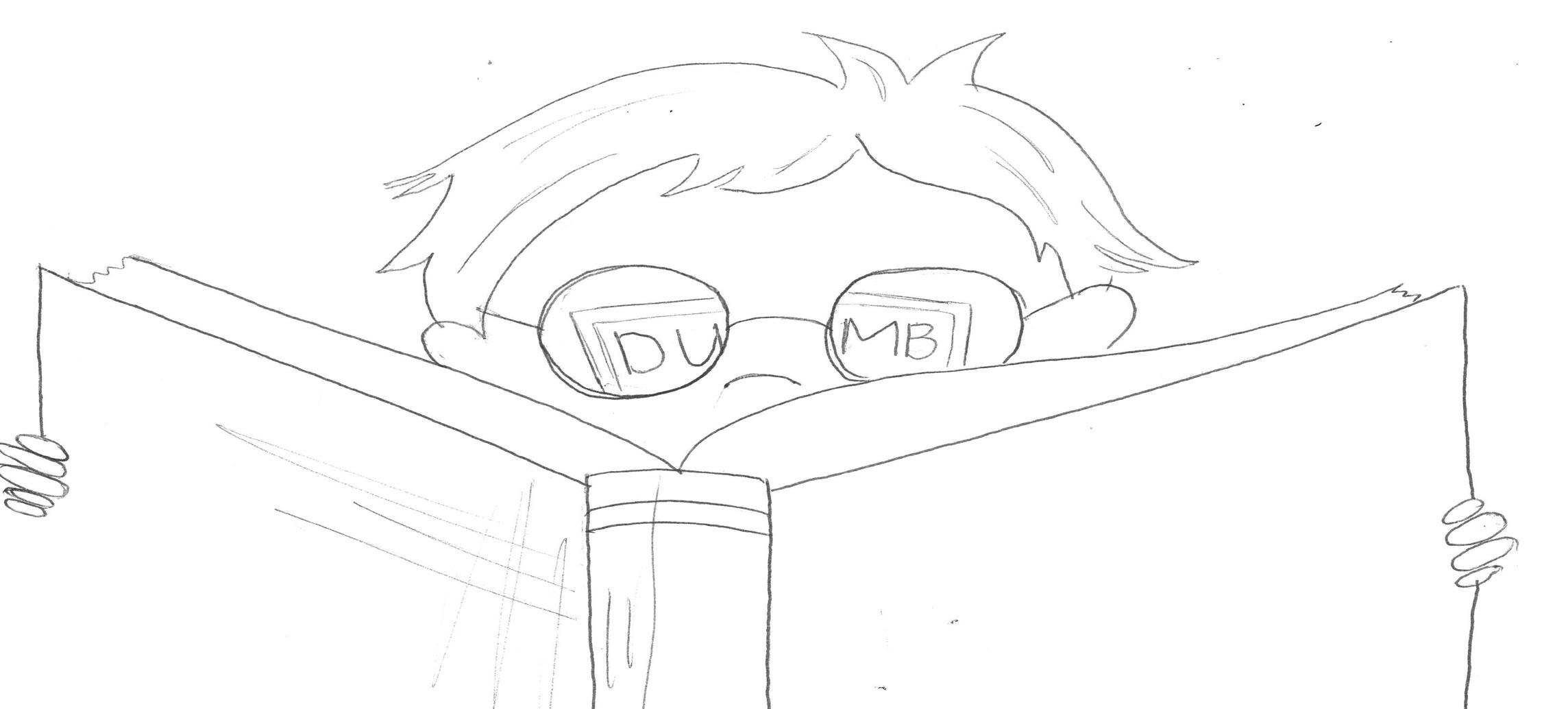
When a dyslexic person has trouble learning to read, it may seem like they are an anomaly amongst tradition al thinkers. Unbeknownst to most however, the human brain was never developed with the ability to read. According to the Scientific American, reading is a practice entirely unique to humans, that’s only been relevant for a few thousand years. A third of the brain links visual system and language regions together, otherwise known as the “wordbox.” The development of all our wordboxes starts when we begin to learn how to read, as we are trained to recognize shapes that look like words.
The process of learning to read seems like nothing out of the ordinary - it’s what every kindergartner embarked on in their early years of school - but for a dyslexic, that process is not quite so easy. “Someone who does well with reading and writing has a different brain set up, where those parts of their brain more active than a dyslexic student. When you teach a dyslexic student how to read, you have to make connections in their brain that haven’t existed before. That’s why that instruction is so targeted and specific, because it’s designed to build pathways between parts of the brain that a dyslexic student’s brain that isn’t generally activated,” says McGuinness. The Orton-Gillingham reading program is a well known and successful reading education approach for not only dyslexics, but is a successful and beneficial approach for all kinds of thinkers and students. Within ORHS, there are two teachers currently certified in the strategy, McGuinness being one of them, with a certification in the Wilson approach, a branch of Orton-Gillingham. Traditional reading instruction won’t always work for kids with dyslexic students because it doesn’t build those pathways, but there are strategies to give students with dyslexia the tools to succeed.
There are other plans that can be enacted to help dyslexic students. An Individualized Education Program, or “IEP,” is a federal and state mandated document for most students within special education that covers goals, objectives, accommodations, and modifications. Every IEP is specific to every student.
At Oyster River, the team behind special education makes sure that every IEP is met, and no student is left behind. This can be facil itated by the assisted study halls, a.k.a. study skills, given to every special education student, or with the help of any one of the 27 paraeducators within the building. “I really think ORHS and the district does a nice job of paying close attention to students strengths

and acknowledging that we all have strengths and weaknesses. As a district, we try to meet all kids needs, regardless of IDEA (the special education federal law). There are a variety of accommodations that can be made and specific goals and benchmarks that can be implemented to support kids,” said Misty Lowe, the Assistant Director of Student Services at the high school. Lowe works beside her team of special education counselors, paraeducators, and case managers to ensure that every child is supported in a way that allows them to succeed. “There's just a variety of people who are very gifted at what they do and are very good at helping kids.” While navigating school can sometimes feel like an uphill struggle, there is certainly a multitude of support and a range of accommodations that can be made.

Dyslexia does not just affect the diagnosed, but touches their family, friends, and educators in a multitude of ways. “It can be scary as a parent. You wonder what the future holds, but because of her positive attitude, her hard work ethic, her confidence and determination and resiliency I have no doubt my child will be a success. She is used to having to work harder and is not afraid of it,” says Amy Jones. In tandem with working with the school and her daughter’s special education team, Amy Jones will read her daughter’s English class books aloud and record them. This allows Jones to read along with the recording and absorb the information better.
“The biggest impact it has had is just learning how to see things differently. I’ve always thought about people learning in one way, and experiencing the world in one way. When I watched him go through his different experiences, I realized there’s not just one way to learn about or experience the world,” said Kate Johnson*, the parent of a dyslexic child. It is an unique experience to grow up in the close proximity of a dyslexic because it is an eye opening way to experience the world through a different thought process.


While dyslexia is an obstacle, it is not a downfall. Dyslexia can serve as an opportunity to shape those people willing to go the extra mile into hardworking people. “I see it not nec essarily as a setback, but as a difference where I know it makes me work harder than others, and in the end will make me go further,” supports Amy Jones. She remembers her school experience in the 80’s. “Often I was told that something just couldn’t be done, particularly in the manner I was approaching it, because my approach to everything was very nontradi tional. I just didn’t understand and do things the way other people did but I still really wanted to succeed at my goals. By the time I got to high school, when people told me something couldn’t be done [that way] I would look at them and say ‘where there’s a will, there’s a way and with me, there’s always a will.’”
The definition behind the word “grit” is much clearer than that of dyslexia. Having struggles in early life tend to create “gritty” people, who often gain more from their hardships than what was lost. Dyslexia, along with many other learning disabilities, comes with its fair share of obstacles and misconceptions, but it also comes, in some instances, with grit. Most questions and problems that come with everyday life present some sort of roadblock. It is when these roadblocks come about that dyslexics are able to navigate alternate routes around where many traditional thinkers would stop. While grit and dyslexia are two separately defined words in the dictionary, the two often go hand in hand. The adversity of the diagnosis has the ability to reveal character, and a gritty one at that. “Without question, it’s a superpower. Without question. They think outside of the box and come out with the most extraordinary responses and answers to these incredible problems,” Johnson affirms.
Tonight, I sit next to my brother at the kitchen island. He comes home every day brain tired, often discouraged, but always deter mined. He is dyslexic which does not make school easy. After school is better, but it’s not always a relief. His determination is impres sive. I have watched him persevere and endure tutors, extra help, and climbing mountains of frustrating lessons since we were little. But I have also watched him set goals, work to meet them with resolve, sticktoitiveness, determination and that I’ve seen in no other. I’ve no doubt he will meet his goals because dyslexia has taught him how to do this.
-Grace Castonguay ArtworkbyChloeJacksonShe is the friendly face at Oyster River, whose warm person ality in the front office creates caring relation ships with the students who inevitably cross her path. Whether you are early and passing through, or late and rushing by, Lisa Richardson is the smiling face you see every day.
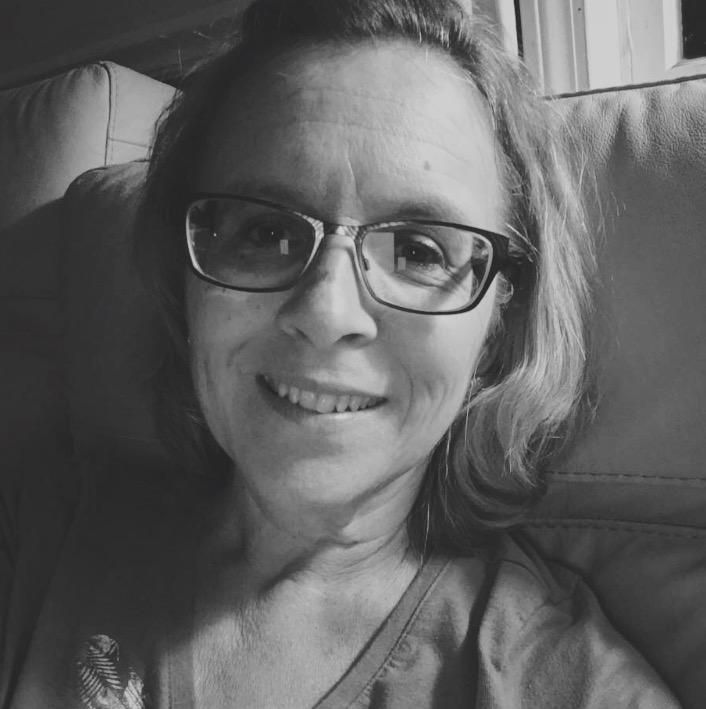
Even through the many friendly encounters (and tardies), it is easy to say that the average student won’t get to know Richardson beyond the front desk. But how well do you actually know the secretary extraordinaire of Oyster River!
Richardson began her life in Hampton Falls, NH where she was raised by two English parents, and grew up alongside three older brothers. In her own words she, “was a little spoiled,” in comparison to her brothers.
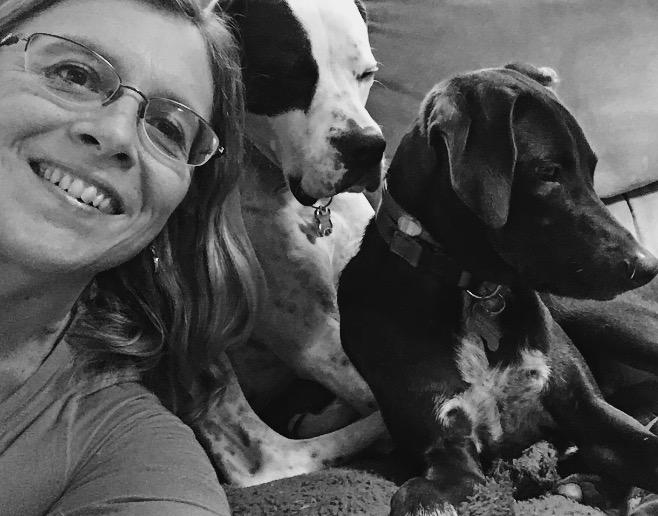
She attended Winnacunnet Coop School District in Hampton, before attending the Thompson School for Animal Science at The University of New Hampshire. She realized that the science field was not geared towards her interests after a year so Richardson pursued a business degree instead.
She then began working in offices, trying to stay in a work place related to animals but eventually shifting into sales. “I worked for fourteen years at Northern Utilities where I was in the sales office. Then they got taken over by Unitil and my posi tion was terminated. I actually took a severance package, and took three years off to be with my [two] kids,” explains Richardson.
Richardson then took a job at the Durham Police Department, where she worked part-time, taking payments for individuals with parking tickets. After this Richardson began her time at Oyster River as a receptionist. “I came here for the interview because I thought it would be perfect for a parent. I would have all of the vacations off and the summers off, and the hours were good. And now, here I am twelve years later!”
Richardson’s dedication to her work is evident through her immensely positive effect on the students. “She’s the first face you see when you come through the office in the morning! She’s very friendly with everyone, and is helpful whenever you have a prob lem,” says Kerstin Nielsen (‘19) who reads the announcements with Richardson daily. “She genuinely cares about students and helping them out when they need it.”
Abby Craig (‘19) describes what makes Richardson unique to the school. “Every time I have been late, she has always said good morning to me and told me to have a good day, which is nice because I’m already stressed enough about the fact that I’m late.”
Richardson’s unique approach with the students allows for a closer connection that reaches beyond the desk that separates secretary and student. Her coworker and fellow receptionist Deb Jabre (or as Richardson would call her, “Deb Deb”) explains, “Lisa can remember almost all of the students’ names and the parents. She enjoys the contact with both the students and par
ents. She is always smiling and helpful. She works well with the teachers and other staff members too.”
With just a smile or a joke, what was once a purely transac tional relationship, turns into a lasting bond.
“My favorite thing about the job is interacting with all of the kids,” Richardson explains. She says that others tend to approach her, inquiring how she feels about constantly being around high schoolers. “But I think if you get to know them, and you just talk to them you know they’re real people, and you really get to know them in the four years they’re here.”
Student Sophie Moore (‘19) describes this bond. “Every time I get picked up on Thursdays, [Mrs. Richardson] comes up to the car to say hello to my mother and to pet my dog,” she says. “She’s definitely one of the most well known and most liked staff members at Oyster River High School.”
Richardson identifies herself as someone who is not overly complicated. She dislikes winter, for the bitter cold, the snow and the shorter days, but enjoys the summer, warm weather, and taking long walks. She loves caring for her dogs, raising her chil dren, and going to the movies with her husband, and she wishes to travel in the future (preferably Italy).
Richardson has a special connection to England since both her mother is from London and her father is from Wales. “I want to go back there and stay a bit longer,” she says. “I have gone there quite a few times when I was growing up and a couple of times with my husband and kids. My husband and I joke about retiring there and having a farm with lots of dogs.”Wherever she may go, she is sure to bring her bright personality and love of dogs with her.
“Lisa is a great person to be around. She is family oriented and she is an animal lover. She has adopted rescue dogs. She is trust worthy, has a sense of humor, patience, caring of students and always helping in any way. I am glad to know her and can’t think of a better person to work beside.” says Jabre.
To the student body and to all around her, Richardson is known to be a positive light within the Oyster River community, sure to brighten anyone’s day. Next time you find yourself waiting in the office, be sure to spark up a conversation the people be hind the front desk. It’ll surely leave a smile on your face.
-Anna SourdifYour stomach growls. You put your pencil down and look long ingly at the board as your teacher finishes the notes. The hunger pains turn your stomach and your head aches as you quietly slide your notebook into your bag, hoping the teacher doesn’t notice. The bell rings. Scrambling to grab your bag, you walk quickly down the stairs, and push through the mass of students to enter the cafe. Fi nally, after surviving the wait, it’s time for lunch.
Those feelings, that many students experience, are more than just an anticipation of lunch; they’re the result of being hangry. The idea of being hangry is a scientifically proven occurrence used to describe a shift in someone’s mood based on a lack of glucose to their brain. The word hangry is a portmanteau word, a linguistics term for the blending of two words using both their meanings and sounds; han gry is a combination of hungry and angry. When someone is hangry, the feeling doesn’t just have an effect on their mood, but can have a great impact on their ability to learn and retain information. With the new schedule at Oyster River High School, lunch on two out of the three days in the rotation can be as late as 1:15 pm causing many to experience a lethargic or withdrawn feeling in their classes.

A student’s diet has an immense effect on a students ability to learn. “If someone isn’t eating, their blood glucose levels are going to drop, and that can definitely change their mood and their ability to think,” said Maggie Dylewski-Begis, Ph.D. R.D., assistant clinical professor at the University of New Hampshire and a registered dieti tian at Shriners Hospital for Children.
A student’s mood isn’t the only impacted aspect of their day. One’s ability to remember and retain information is greatly impacted when fasting for large amounts of time. “A decrease in blood sugar will interfere with your ability to learn or process information because at that point your body is just thinking about how to metabolise what it currently has,” said ORHS school nurse Kimberly Wolph.
Snacking throughout the day is a way to break up the time that is spent without glucose being taken into the body. “I encourage students to pack snacks in their bag to prevent that exact scenario,” added Wolph.
Schedule changes at the high school were greatly altered to incor porate a new program in the school day: Flex. “Flex was the keystone to the whole schedule and we didn’t want it at the end of the day. We wanted it before lunch and we wanted something before and after Flex, so that’s where lunch ended up falling,” said Mark Milliken, Dean of Students at Oyster River and head of the schedule committee.
The new shift in schedule greatly lengthens the time between when most students eat breakfast and lunch on school days. “1:10 is really late,” said Celeste Best, a science teacher at Oyster River. “I have kids when we are doing check in, who are sitting in the front and eating pizza and sandwiches, not snack food. They are eating their lunches.
Ones I have talked to say, ‘I bring double lunch, one to eat in here and one to eat in lunch,’” she added.

Students have had to adjust to the new schedule, planning
times to fit snacks into their day. Emma Hilary Gould (‘19) talked about how she believes students have had to adjust to the new sched ule change and how planning snacks is now an important step in her morning routine, saying, “it’s tricky if your E period class is a science class or band where you can’t eat during the class because then you are really trapped. You are hungry and it’s unfortunate and it’s a really, really long time before you can eat.”
Liev Manck (‘19) acknowledged that his mood and ability to focus are significantly impacted when he is hungry. “If I’m hungry, my stomach is literally hurting and I have less energy… I don’t want to do my work or I’m more likely to be on my phone and distract myself,” said Manck.
Many classes and even entire departments have made adjustments to try to improve situations that have arisen based on the time of lunch. “Typically [the science department] has said ‘no food or water in labs, period.’ And then the science department started talking about it, and we decided that those of us who have E period, we can let kids eat in the front part of the rooms, not in the lab spaces. If we didn’t, I don’t think the kids would be able to focus,” said Best.
Although students are provided with the opportunity to eat snacks in some classrooms, not all students have access to food throughout the day. Students who participate in the free or reduced lunch program are eligible for breakfast before school and a lunch during their scheduled lunch time. This could consist of a student eating at roughly 7:45 am and then not again until 1:10 pm: almost 6 and a half hours apart with no food.
“Those kids are probably not going to come to school with snacks from home, and what if they can’t get them?” Best said. “It could be a problem if there isn’t food at home to throw into a bag for snacks in class. Then they are stuck, and that means their learning is suffering, not by their choice,” she added.
Gould agreed with Best, saying, “I think every kid should be able to go to school and not have to worry about something fundamental like whether you can eat or not.” Gould went on to say, “the fact that [having food] could be trouble and a concern for some kids seems unfair, and it perpetuates an inequality there because other kids don’t have to go through that same feeling.”
Best talked about possible solutions, saying, “the number one solution would be to move lunch earlier. But then you are talking about it being early. There are [negatives] in both ways. Some kids go right to sports after school so then they wouldn’t eat until 6 or 7 at night. If you are eating at 10:30 am it’s the same problem just on the other end of things.”
Milliken acknowledged how late lunch is and the effects it can have on students. When asked about possible solutions, he connected it back to the sched ule, saying, “when we proposed and implemented the schedule we did so thinking it’s a work in progress, and we are open to feedback.”
- Joe Morrell Artwork by Hannah Jeong28th, 2018, seizing thousands of the company’s documents associated with marketing and sales to see if there had been any intentional underage targeting.

Two weeks later, the FDA had yet to release the findings and implications of the raid, leaving Juul Vapor to take preventative action into its own hands in order to avoid po

The statement went on to detail that while these flavors will continue to be sold to users 21 years or older online, a monthly restriction would be implemented on both pods and devices through tracking users’ account activity. In addition, the company promised to continue to use a third party verification system, in an attempt to ensure that the

website is only being accessed by adults.
On November 15th, the FDA Commissioner, Scott Gottlieb, directed the Center for Tobacco Products to revisit former policies regarding the production and retail of flavored pods, calling for the decisions of Juul Labs to be reinforced by legislation change.
With Juul Vapor currently controlling 72% of the e-cigarette market according to the advertising data collected by Nielsen ratings, these updates could have major impacts, some of which, right here at Oyster River High School.
As suggested by the numbers, there is reason to believe that the new supply regulation on Juul products will have a positive correlation on the decline in underage use of electronic cigarettes. However, with many students already hooked on the device, the issue of how to rebuild an addic tion-free learning environment still remains.
To begin answering this question, high schools across the state have been carefully tracking the number of stu dents who use electronic cigarettes regularly, with Oyster River being no exception. According to ORHS’ last Youth Behavior and Risk Survey, which was recorded during Juul’s growing popularity in 2017, nearly one fourth of seniors had vaped within the past 30 days.
“I think that number has since increased for both seniors and other students,” said Robert Quaglieri, the high school’s health teacher, regarding the survey’s current relevance.
In addition to this num ber’s increase, Quaglieri also believes that the ban on selling fruit flavored pods will not stop underage use if the teens have already become addicted. “The number of students using will most likely stay the same, because [the users] still need to have a lot of nicotine in their system if they have been using for a while.”
Quaglieri’s thoughts bring up another critical point regarding how Juul Labs was able to grow their company so quickly: the potency of their products. “One Juul pod is equivalent to a pack of cigarettes [in nicotine content]. Most users are using more than one pod in a short amount of time, so as their addiction levels become greater, the withdrawals are going to be greater, so they will still be needing to use more nicotine-based products,” he said.
One user, who remains anonymous, revealed that they would continue to use their Juul, despite the new restric tions in stores. “I don’t understand how removing fruit flavors is going to stop anyone. I’m just going to switch flavors to make sure that I can keep using,” they said.

This was seconded by another anonymous student, who also agreed that they would continue to buy the remaining pod options still being shipped out by Juul Labs: mint, men thol, and Virginia tobacco. “Everyone who uses is already addicted,” said the student. “[Juul Labs] got people reliant on the good flavors, then just took them away knowing people would continue to use what’s left.”
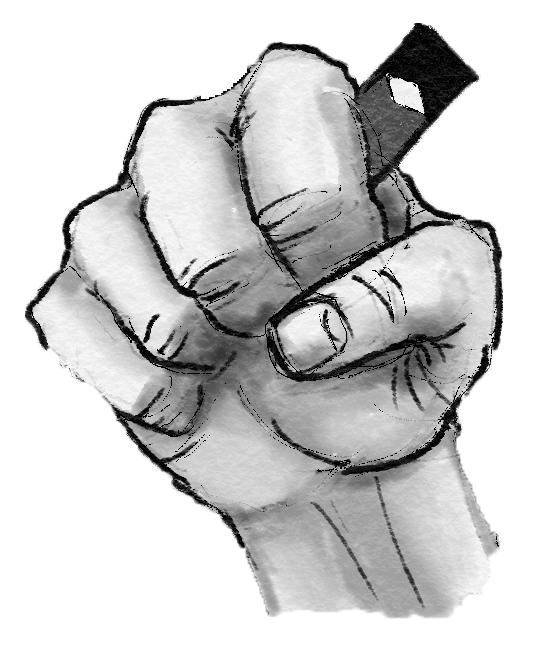
Alongside having an abundance of sweet flavors, Quaglieri believes that Juul’s heavy social media presence also attributed to the device’s popularity among younger users. “Juul did a massive social media advertising cam paign, which caught the eye of a lot of kids, who are typically exposed to a lot of social platforms,” he said.
This campaign, which featured younger-looking models and ran pri marily through the social media site of Instagram, did have the potential to reach millions of underage users. According to the Pew Research Center’s Internet and Technology branch, 72% teens in the United States have Instagram accounts, which do not use age verification when users register using a birth date.
This meant that if teens wanted, they could still view the Juul Lab account through entering a fake birthday which would give them access to the company’s posts that featured young adult users. This later resulted in an FDA accusation of deliberate marketing to those un derage, followed by a removal of all Juul Lab’s social media sites, with the exception of Twitter.
However, while the new shift in marketing may prevent some extent of underage use, many believe it is still not enough. “Upperclassman that are already using won’t stop because of the lack of a flavor,” said another anonymous source. “Even if the number of users decreases due to the banning of fruity pods, there is still a big issue because of how much the public sees those who are already addicted.”
Like marketing, the public view of Juul addictions has also primarily come from Instagram, where there are countless, third-party accounts showcasing the use of Juuls among a younger audience. These accounts not only serve
to push forward Juul’s exposure to youth, but can also glori fy the product’s use between peers with little regard for the potential health concerns.
“Stopping the social media campaigns was part of a big step in trying to prevent underage use,” said Quaglieri, adding, “but there has still been a major study that shows that e-cigarettes affect a student’s learning ability to move through high school and potentially move on to college.”
The study Quaglieri refers to was conducted by the Unit ed States Surgeon General’s Office, and it showed that nico tine, like that from an e-cigarette, has major developmental impacts on the learning centers of a developing brain.
A forth anonymous source attributed this new research, alongside the removal of flavored Juul pods from stores, to their decision to quit within the near future. “I’ve hon estly been thinking about quitting anyway, so having more restrictions on access to Juul pods definitely pushes me towards quitting because it’s just not worth the trouble or health issues,” said the student.


The student also thought that the new restrictions would deter potential new users, saying, “the craze is pretty much over, and as they take out the fruit flavored pods and market it more towards adults, I think that’s going to result in a shift in the attitudes of younger users who will see it as less cool and accessible.”
With changing attitudes such as these, ORHS hopes to focus on providing students with resources to help them re cover from addiction. “We have a licensed alcohol and drug counselor (LADC) at the school,” said Principal Suzanne Filippone. “Students can go to see this individual if they are feeling the need for any kind of alcohol or drug related counselling. That is a confidential source, and the infor mation is not shared with the administrators or anybody else, even parents.” According to Filippone, the LADC can be contacted through any teacher, administrator, or school counselor.
In addition to providing resources, some schools are also taking a disciplinary approach to stopping underage vaping. Most recently, Rochester’s Spaulding High School implemented a new procedure that automatically refers students caught using Juul devices to authorities, according to “Spaulding High School unveils new electronic cigarette policy” from Foster’s Daily Democrat
Though Filippone did not reveal if Oyster River was going to follow a similar path, she is hopeful that education on the issue will be key to its eventual resolution. “[The staff] really wants to talk with students about vaping,” she said, also mentioning that the most recent parent newsletter had resources on the dangers of underage nicotine use. “We want to know how we can support kids and what we can do to help kids and parents who are looking for help.”
Smoke by Devan McClain
All other artwork by Emma Kovalcik
Logo courtesy of Wikipedia Commons
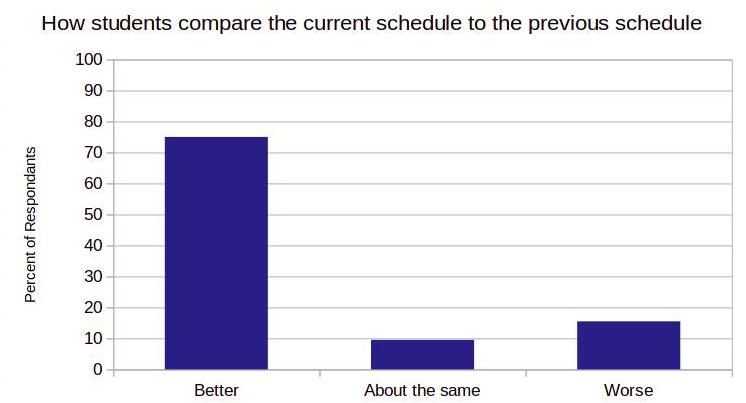
The first of two recent voluntary surveys given to ORHS students found that between 70.6% and 79.4% of the entire student population found the new schedule overall better than the 2017-18 schedule. The new schedule is now benefiting stu dents by reducing stress and increasing access to teachers.
In the 2017-18 school year, Oyster River moved to a lat er start time - shifting from a 7:35 am start to an 8:15 start. The schedule used for that year received many complaints and has since been replaced with a new and improved schedule. The 2017-18 schedule received many com plaints about the end times of classes, with many classes ending at strange times and leading to wasted in-class time. The new schedule hoped to make classes end at better times to maximize class time and reduce student stress.
completely voluntary. The first survey accepted responses from September 28th to October 15th 2018 and received eighty four responses. The second survey accepted responses from November 16th to November 21st 2018 and received seventy nine responses.
In the first survey, fifty 0f the eighty four respondents were seniors, twenty were juniors, and fourteen were sophomores. In the second survey, forty one of the respondents were se niors, sixteen were juniors, and twenty two were sophomores. The ranged data was found by calculating the confidence in terval, using a school population of 817.
Between 70.6% and 79.4% of the entire student population found the new schedule overall better than the 2017-18 schedule
As discussed in an article titled “Flex” By Devan McClain of issue three of MOR last year, the new schedule is block fo cused, meaning instead of having every class every day, stu dents only have half of their classes every day. The schedule also rotates, so no specific day of the week has a set schedule.
The resistance of change is why I decided a series of sur veys would be the best way to gauge how perceptions of the new schedule changed over time, with the assumption that in the be ginning of the year the schedule would have less support than it would be later in the year. Students in all grades of Oyster River High School were asked to participate in the survey al though no freshman did participate in the survey. The survey was
One of the largest benefits, to both stu dents and teachers, is the decreased amount of stress. The new schedule was designed to reduce stress in two ways: by reducing how often students see each class and by making the end times of classes more predictable.
The surveys show that the new schedule has lowered student stress significantly. The first survey found that between 77% and 85% of the student population had less homework this year. Charlie Haskell (‘19) explained that the new schedule, “has reduced my homework a little bit, but not a whole lot because a lot of my teachers are just doing double the homework. I think it’s definitely a step in the right direction because I’m getting less homework and I get to not think about home work for some classes for a few days and then come back to it.”
Less homework has been a major point for many students in their case for why the new schedule is better than last year’s schedule. Since students only see each of their classes two out
of every three days, it gives them more time to spend on each homework assignment. Additionally, the new schedule allows for students to take a break from a class for a day and to put homework out of their mind for a day before coming back to it.
Teachers, like students, have also had reduced stress with the new schedule. Mark Milliken, head of the committee that created the new schedule, has said that teachers have reduced stress this year as well. Milliken explained that, “I’ve gotten a lot of positive feedback from adults and kids. A number of adults have said that they feel a lot less stress.” Similar to stu dents, some teachers now have less stress with the new schedule.
The reduction of stress was one of the schedule commit tee’s goals when creating the new schedule. When the committee be gan working, they surveyed both students and teachers to identify the biggest issues they should be solv ing with the new schedule. Accord ing to Milliken, the three biggest issues students had with the 201718 schedule were the hectic pace of the day, the amount of homework/stress they had, and the inability to connect with teachers during the day.
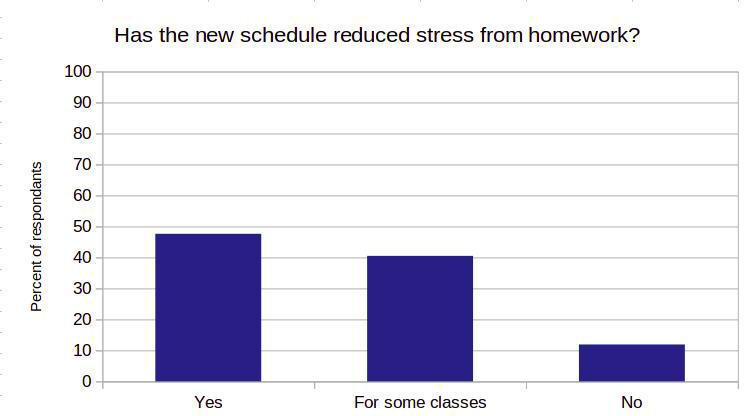
Another benefit, which was discussed in more detail in an article by Abby Schmitt, is Flex time. Haskell takes a class through the C.A.T.S (Challenging Academically Talented Stu dents) program at UNH. Because of this, she has to leave the school a few days every week to take her class. Flex time, however, has been vital to her success in the classes she miss es. Haskell explained that, “I miss almost all of AP U.S. Histo ry so I’m never there which is really inconvenient. But Flex has made it so that I can make up my tests at least, so I’m really glad that Flex is there because otherwise I’d be kind of drowning.”
While Haskell has been able to work with her teachers in Flex to make up missed time, Max Carpenter (‘19) has had a dif ferent experience with the C.A.T.S Program. Carpenter believes that the C.A.T.S program should be more easily accessible. He explained that, “this schedule working on a three day cycle makes it so you have to miss 3-4 classes in order to use the C.A.T.S program, which is one of the best programs the school offers.”
While Carpenter thinks more could be done to make the
C.A.T.S program more accessible, he still agrees that the new schedule has reduced his nightly homework load in many of the ways it has reduced Haskell’s homework load.
Carpenter and Haskell both have found things they enjoy and think could be fixed in the new schedule. Haskell agreeing that the new schedule has reduced her homework and is gener ally in favor of it, she does believe that changes should be made. Haskell explained that, “we don’t get a whole lot done on bob cat day because every class now is so used to the block schedule. … It’s kind of like a two hour delay schedule where nothing ac tually happens, and then we’re all just stressed for no reason.”
Bobcat days are the one day of the three day cycle that is not a block schedule. Students see six of their seven classes for fifty minute blocks. Many students noted in the surveys that they agree that bobcat days add in unnecessary stress and that a block-on ly schedule would be more benefi cial and would increase usable time.
Henry Duisberg (‘20) agrees that the new schedule has been overall beneficial, saying, “it definitely reduces my home work load at night and it’s a lot less stressful during the day.”
Duisburg also agrees that Bobcat Day can increase some of his stress, but believes the larger problem is in the rotat ing schedule. Duisberg explained that, “it’s very hard some times to keep track of which day it is because it’s pretty stressful. At times, you do your homework for the wrong day.”
The schedule was designed to rotate so that if there are any snow days, classes still have the same amount of class time no mat ter what period the class is. The schedule doesn’t assign a schedule to a day of the week and is based on what the previous day was.
Milliken explained that the current schedule is just a step in the right direction and is still open for discussion and change, saying, “when we designed the schedule it was with the idea that this is the best effort now, but that we would continual ly revisit it and find out what works and what’s not working. We have to give it time, it hasn’t even been half a year yet, but we would like to gather feedback from adults and parents and students closer to the end of the year. It’s not a schedule that we expected to be written in stone and never change.”
-Lucas Hamilton“I think it’s definitely a step in the right direction because I’m getting less homework and I get to not think about homework for some classes for a few days and then come back to it.”
Oyster River High School debuted an array of changes in the 2018-2019 school year. Alongside the new schedule, there was a notable revamp of Advisory to include a period called Flex.
This fifty minute Flex block is a main feature of the new rotating block schedule at the high school. The period serves as a time for students to independently complete homework, receive academic support from their teachers, and relearn and reassess class material during the school day. With proper use of this time, students could leave school with a smaller workload. Now, after having the period in the schedule for nearly half of the school year, the hope is that students are enjoying and using the block appropriately.
In the Spring of the 2017-2018 academic year, ORHS administration created a SurveyMonkey that included a questionnaire about the schedule. This survey was sent out to all of the advisories in the school and received 500 responses. The poll concluded that many students were concerned with stress levels and the amount of homework they were receiving based on the schedule. Because of this, administration deemed it beneficial to add this Flex block into the new schedule. On page fifteen, further details on the schedule can be seen in Lucas Hamilton’s article, “New Schedule.”
article, as well as the article about how students are liking the new schedule. Based off of the 79 responses that were received, it was concluded that, for the whole school, between 40.1% and 61.1% of all people would agree that Flex was a beneficial change.
Although many students, like Moore, have been enjoying Flex, there are still concerns about the program.
Amelia Concannon (‘19) mentioned that, “Flex is a good time to finish some homework assignments, but it’s definitely not enough time to finish all of my homework, especially when the block is split between Flex and Advisory.” One of the benefits of Flex is to allow students to get a head start on their homework load, but, as Concannon said, not to entirely complete it.
While the main purpose of the new Flex block is devoted to connecting with teachers and receiving academic help, Concannon is referring to the split between Flex block and Advisory three times a week. The new period still differs from complete blocks of Advisory last year where students were limited to discussion based periods and were only able to receive outside help during Office Hours twice a week.
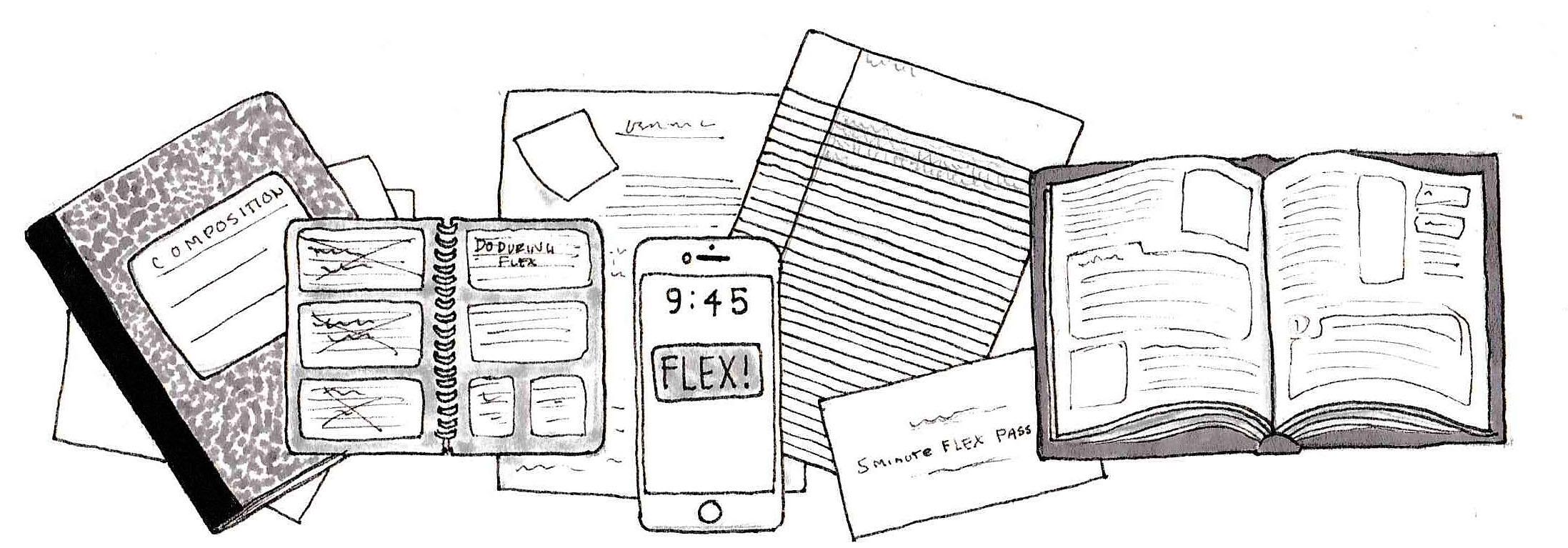
Oyster River High School’s Dean of Faculty, Mark Milliken, reiterated the purpose of Flex and said it “provides students a chance to get academic support, social/ emotional support, a break in the school day, and a time to get work done.”
Advisor: Cathi Stetson
Description: Opportunity for students to focus on the use of digital cameras.
Advisor: Tracey Benkosky
Description: Opportunity for students to move, chat, clear the mind, and lessen stress during the day.
Advisor: Tracey Benkowsky
Description: Opportunity for girls interested in STEM to explore their interest in science.
Teachers and students alike have been taking advantage of the period. Sophie Moore (‘19) stated: “I am always using it to my benefit, whether that’s just to read and listen to music for a break in my day or to work on homework.”
Along with Moore, other students have benefitted from the Flex block. This quarter, a Google Form that consisted of questions regarding the new schedule and Flex was posted in each of the high school class’ Facebook pages. This information was used for both this
An ORHS English teacher and a parent of two students in the high school, Kara Sullivan, noticed that this change from Advisory to Flex has made a notable difference. “Eighty percent of my students are now using the time effectively. That does not mean that they are working nonstop, but sometimes they are working and sometimes they are relaxing.” The other twenty percent of students in her Advisory “are on their phones when they could be doing work [during Flex],” she said.
Despite this, Milliken highlighted that he is confident that most students are using this block productively. “The hallways are mostly empty during Flex meaning that students are in classrooms. Last year, it was crowded and chaotic in the hallways, but this year, it seems like more students are using Flex appropriately,” said Milliken.
To support Milliken’s claim, the survey concluded that, between 83.6% and 96.2% of students in the entire school are using Flex to work on homework, between 61.4% and 80.4% students are meeting with teachers for academic support, and between 44.0% and 64.8% of students are making up tests or labs.
Along with getting work done, students spoke highly of their opportunity to meet with teachers during the Flex block. Tucker Henry (‘19) mentioned that he has been able to meet with his teachers for extra help, as well as to clarify homework assignments and make-up work that he missed because of sports dismissals or from being absent.
However, Concannon brought up the fact that being able to
get scheduled to be in another teacher’s Flex time is sometimes difficult. “At times, I have a hard time scheduling to meet with teachers, which is inconvenient. Also, when I forget to schedule myself with a teacher prior to the day of, I am not allowed to. That’s hard because I sometimes forget that I need to meet with a teacher,” said Concannon.
The survey supported Concannon’s point, showing that between 42.7% and 63.7% of students in the entire school would agree that their scheduling out of Flex has been only somewhat successful.
In response to this, Milliken noted that the Flex Committee has been discussing the process in which students can schedule themselves to go to another teacher’s classroom for Flex. He said, “soon, the scheduling for Flex time will be rolled out to students and will most likely [be rolled out to] upperclassmen first. Then, we will see how that works.”
Along with the scheduling process, some individuals are concerned with the amount of students signing up to meet with one particular teacher during the same Flex time. Moore said, “the teachers always seem overwhelmed when we go in for help because they have so many students in Flex from different classes and at various levels.” She continued, saying, “this gets in the way of them being able to help everyone, and then the teachers are more stressed and the students don’t get the help they may need.”
Although Moore’s point poses a problem, Flex does provide teachers with a block of time in their schedules to meet with students for academic support or for make-up work and assessments. “It’s much easier to schedule students for make-up work, or for a student who is having a hard time with an assignment to come in and talk about the assignment with me,” said Sullivan.
Even though teachers can provide their students with extra assistance, the period is taking up necessary class time. Bill Reeves, an ORHS mathematics teachers, stated: “Flex is a great opportunity, but losing class time to do it could be ineffective. I am worried about the timeline for AP classes with Flex time because there is a hard deadline.” He continued, saying, “[in comparison to last year’s schedule], every three days we lose twenty minutes of class.”
However, the cut-down of class time has made this block a useful break in the day for both students. “I like the placement in the day; it gives students a break between blocks. In terms of giving everyone a breather, it is super helpful,” said Sullivan.
This free time has been especially advantageous for Jenna Young (‘22). She mentioned that Flex has helped with her transition into high school and she said: “it has been really helpful for me when studying for tests and getting extra help, especially when I miss a class for sports.” She added, “I feel less pressure when I get a sizable amount of homework and know I have Flex time to do it.”
Because students have been able to use this period to complete work or for down time, they have had more free time outside of school. Moore stated: “my workload is definitely lighter due to Flex. As someone who has a job and a lot of extracurriculars after school, Flex time is incredibly useful.”
Now that students are receiving extra help, a break, and more time to do work, some say that their stress levels have even been
reduced. Moore expressed the fact that she is a little less stressed now that Flex is a part of the schedule. Now, she can see teachers or her peers for group projects during school instead of having to come in early or stay late.
In turn, this is minimizing some teachers’ and parents’ stress levels. Brian Cisneros, a member of the School Board and a parent of Audrey Cisneros (‘21), said, “Audrey is using [Flex] to complete some homework with the help she is getting. This is causing her to be less stressed at home at night trying to get it done.” He continued, saying, “when she is less stressed, that means I am less stressed. Stress can change the dynamic of a household.”
In support of Cisneros’ claim, the survey concluded that for the entire school, between 33.9% and 54.7% of students would agree that the new schedule has reduced their stress levels.
Along with parents, Sullivan noted that, “overall, the pace of the schedule has helped my stress level, just speaking personally. The pace of the day is different.”
Another issue Flex has attempted to address is the timing of club meetings. Currently, a number of clubs are meeting before or after school. Shannon Foulds (‘20), a member of the school’s Student-Athlete Leadership Team, noted: “the [before school] morning meetings certainly throw off my schedule, and I believe Flex time should be used for such meetings. It’d definitely be more convenient if we took advantage of Flex for this.”
Milliken addressed this concern and stated that administration has now allowed clubs to meet two time per month during Flex, and are now also implementing enrichment time to Flex. “However, we wanted to start small and focused so that everybody gets in good habits first,” said Milliken.
Milliken also noted that the hope is that students establish productive routines and continue to use Flex time appropriately and efficiently throughout the course of the school year.
Soon, more options for enrichment time will be available for students during Flex. These options can be seen on both side bars of this article.
- Abby Schmitt Artwork byEmma KovalcikChess Club
Advisor: Marjke Yatsevitch
Description: Opportunity for students to gather and play chess.
Advisor: Celeste Best Description: Opportunity for students to gather and play cribbage.
Exploring Midfulness
Advisor: Kathy Pearce
Description: Opportunity for students to learn about minful ness practices.
Origami
Advisor: Sara Cathey Description: Opportunity for students to explore the art of origami.
Sewing 101
Advisor: Andrea Drake Description: Opportunity for students to learn basic sewing skills, and work up to a takehome project.
Social Justice Issues
Advisor: Jim Thibault
Description: Opportunity for students to focus and discuss social justice issues in the world.
Speaking Games
Advisor: Shauna Horsley
Description: Opportunity for students to improve their skills and confidence in public speaking.
Student Voice
Advisor: Suzanne Filippone
Description: Opportunity for students to connect with the administration and other adults and discuss community topics.
“It has been really helpful for me when studying for tests and getting extra help, especially when I miss a class for sports.”
For the 2018-19 school year, the Oyster River Middle School made the decision to ban cell phones from classes, halls, and lunch from the first bell in the morning, to the last bell of the day. The decision was largely in response to a push from the school board and parents of middle school students to ban phones from the middle school. The transition was made easier as the school went “one to one” at the same time, meaning that every student was issued a laptop and eliminated the necessity of phones as an educational tool.
In past years, teachers have individually decided how to deal with cell phones in the classroom, much like the current policy at the high school. The school didn’t want to ban them large ly because they were a potential educational tool, as students would be able to use them for research and in class activities when they didn’t have access to a computer. However, with each student having their own computer, they always have access to the internet and no longer had any need for phones. Now, phones must stay turned off and in students’ lockers throughout the day. As students are now unable to contact their parents during the school day, the front office has two new phones for that purpose. For the most part, teachers and administrators have been pleasantly surprised with the success of the new system; students have expressed mixed feelings.
Julia Kinsey, an eighth grader at the middle school, was the first student to have her phone taken away with the new policy. She explained, “I thought that if I just made a quick call to my mom in the hallway during the last fifteen minutes of school, that would be fine.” She expressed surprise that she was the first, saying, “before [the new policy], everyone used their phones [...] They were out at lunch time, and we would be allowed to use them in class for research purposes.”
Kinsey explained that students were spending all of their spare time on their phones and before she had a phone, she felt left out. She explained, “at the lunch table all of my friends would be on phones, listening to music and stuff; no one talked. And now that there are no phones, people are playing at recess again and everyone’s talking, which I like.” Despite all of the positive outcomes, Kinsey said, “ I don’t know how I feel about the rule as a whole.”
The initiative to ban phones came from a number of parents
on the school board. Middle school principal, Jay Richard, said that he believes one of their motivations for advocating for a new policy was concern of the health risks associated with screen time.
Richard elaborated on another potential motive for the ban, saying, “I think some parents felt that phones were extremely distracting to kids, and I mean, it can be. The biggest thing was that we didn’t have enough electronic devices for kids to use at school for learning.” Now, the new computers ensure that every student has the ability to access the internet whenever they need. The new one to one system will be covered in greater detail in issue three of Mouth of the River.
He said, “at first I was very adamant [that banning phones was a bad idea], it bothered me that these parents wanted these phones banned and they were taking out the choice of families and teachers who wanted to allow phones in the classroom.”
He changed his opinion after the success of the year, say ing, “looking back on it now, it’s all worked out very well. It hasn’t been a big deal because kids have their own laptops. So there’s no argument anymore why we need to allow kids to have phones in the classroom, because they don’t need them anymore for learning purposes.”
Jon Bromley, an ORHS science teacher and parent of a middle school student, was one of the parents who talked to the school board about the need for a new phone policy last May. Bromley explained that parents brought attention to the issue because the old policy was outdated. He said, “when that was written, the technology landscape was totally different.”
Bromley explained that the technology has evolved too much for the old policy, saying, “no one predicted that a person’s cell phone would have the computing power it does, let alone all the apps and social media that come with it. The internet landscape is the wild west.” Bromley argued that because there was so much to the internet that couldn’t be monitored, phones were becoming an issue at the middle school.
He was concerned about the school’s inability to monitor because of “all the places [the internet] literally can take you that are not healthy for anybody, let alone young minds.” He supported the school’s decision to ban phones, saying, “where it landed was, I think, the right move.”
Additionally, Bromley expressed that he has had no difficulty
“I thought that if I just made a quick call to my mom in the hallway during the last fifteen minutes of school, that would be fine.”
- Kinsey
communicating with his daughter at the middle school. However, because students now have to go to the office to call their parents, Kinsey explained “I’ve noticed a lot more that there are more kids in the office now, in the lobby, more kids waiting for the telephones. I remember one time, I was standing there for like ten minutes as a bunch of other kids ahead of me did their calls.”
Similarly, eighth grader Sonia BarthMalone expressed that communication wasn’t always as easy as it seemed with the new sys tem. “The teachers in the classrooms, they can’t even give permission to text your par ents,” she said.
Barth-Malone found this especially frustrating because, “if you can’t re member somebody’s phone number, you can’t get permission from your teachers to check your phone.” Because of the strict policy, she was unable to communicate with someone to find out whether she had an appoint ment after school.
Valerie Wolfson, a seventh grade social studies teacher, gave her thoughts on the new policy. “I feel like it’s been successful, and I think the vast majority of kids get it. There were a few kids who would beg me, ‘please can I take it out in the last five minutes,’ and we’d just have to say no. But they finally understand we’re actually going to stick with that poli cy,” she said.
Overall, Wolfson hadn’t noticed a huge issue with phones in the past, saying, “there were small infractions here and there [...] Usually it wasn’t a huge deal, but occasionally it was.” Additionally, she noted the success of the policy and her surprise that students adjusted so quickly.

Cathy Dawson, a special education teacher at the middle school who works in seventh and eighth grade classrooms, explained that she thought it was beneficial, “because they’re not distracted. They’re not trying to sneak their phones.”
Dawson also said, “there’s been no push back from the kids; they’ve all been pretty much respectful, maybe I’ve taken two phones. I feel like they are more focused, especially because they have the computers.” Additionally, she found that students are more organized when they’re forced to make plans before school or use the phones in the office at school.
Despite the overwhelming support from the middle school faculty, Wolfson pointed out that the exception that allows for students with an IEP, a 504 plan, or an alternate medical plan to use their phone may give these students some unwanted attention. Students who have a medical condition could use their
phone as a part of their plan, which was established with the school nurse. In the case of a student with diabetes, they would use the phone to track their blood sugar.
Although Wolfson supports the rule, she worries that it may put students in an awkward position. Wolfson stated, “my feeling is, if that were my child and they had to explain to their peers constantly why they were allowed to have a phone, it sort of breaches their privacy because that would make them very much an outlier, so I wonder how that’s gonna play out over time.”
With all eyes on the middle school, Suzanne Filippone, the principal at the high school, explained that the high school hasn’t talked about changing the phone policy, and is unlikely to change its policy. “We have not had a discussion about implementing that at the high school. The discussions around cell phones are more about appropriate use and talking to kids about how to monitor their use and to make sure it’s not interfering with the learning environment, but not necessarily having a bell to bell policy.”
Filippone explained, “I think it’s appro priate for middle school. I can see why they made the determination they did for middle school, I don’t know if that determination is appropriate for high school.”
Derek Cangello, a social studies teacher at the high school, decided that in order to limit phone usage during instructional time, he would dock a point from a student’s quar ter grade every time he sees them with their phone out during
instructional
time. Despite his strict in class policy, Cangello explained that he would likely be against a phone policy like the one at the middle school be ing implemented at the high school. He stated, “I think we’re supposed to be preparing [students] for the adult world.” He explained, “self control and paying attention and doing what you’re told and stuff like that, I think, is a life skill.”
While addressing why he believed the policy was right for middle school but not high school, Cangello stated, “I think in high school you have a lot more responsibility [...] and I think we as teachers should be able to police that and, I think, hold students accountable to not using their phones.”
Artwork by“I think we’re supposed to be preparing [students] for the adult world.” - Cangello
- Susanna Serrano
Charlotte Hambucken
For many, high school is a great time to further explore interests outside of class through clubs and other experienc es. But now that Oyster River’s number of extracurricular opportunities is nearing hundreds, where should one draw the line?
As a freshman, I was left pondering the same question. Attending a school with such a high academ ic reputation meant that there seemed to be an unspoken standard to be a student who could do it all: maintain perfect grades, stay connected with friends, and lastly, excel under a full schedule. So, I made a common, yet dangerous, mistake and stretched myself too thin.
Attending to countless to do lists, pages of overloaded calendars, and a crowded agenda book soon became a priority, eventually over taking my high school experience.
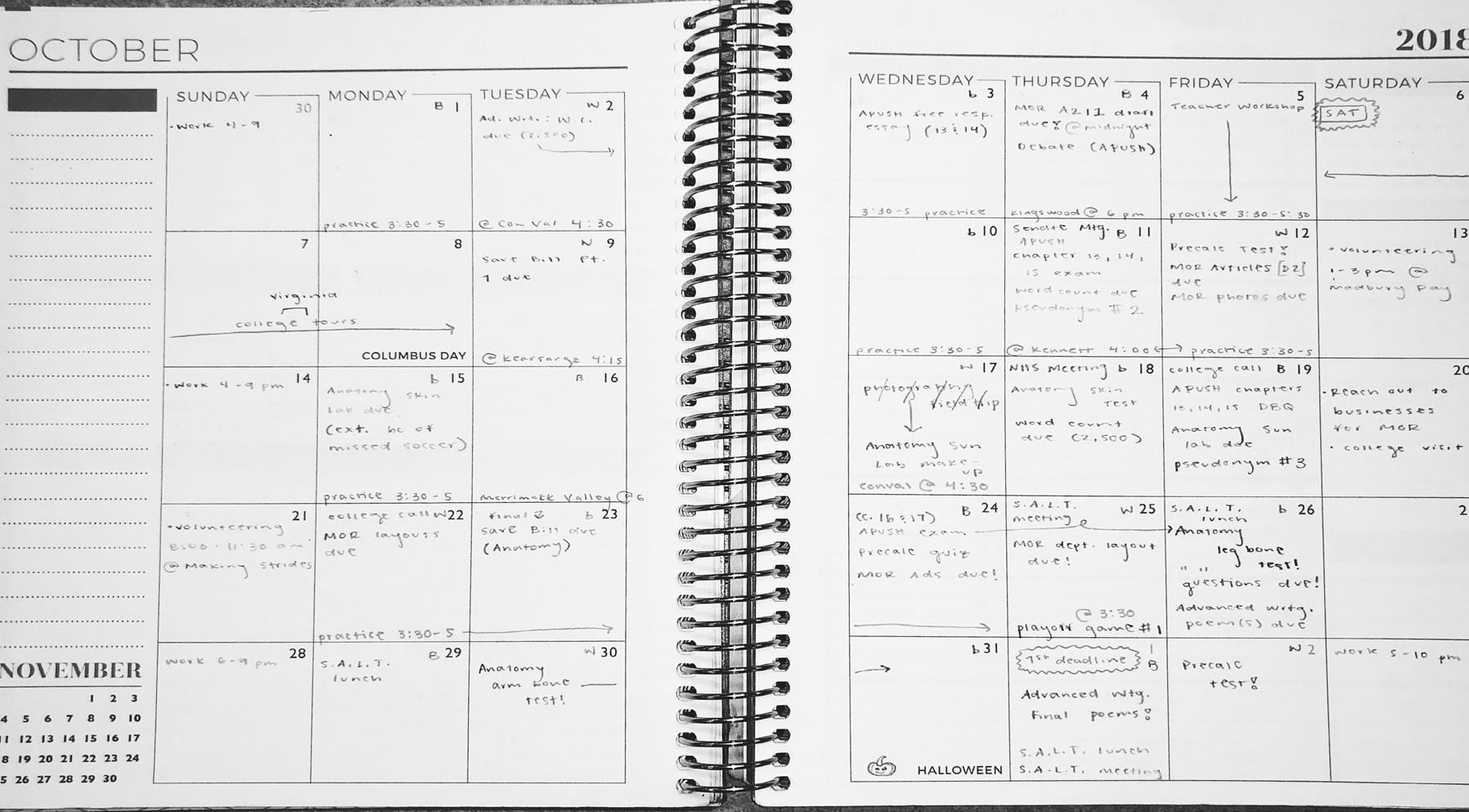
This story may not be unfamiliar, especial ly to those who have been living in the aca demically competitive environment of Oyster River for several years. What may be surpris ing, however, is the fact that the competition to be excellent exists long after the final bell rings and the classrooms go dark.
To me, this meant a lot of confusion with in the next three years of my high school career. On one side of things, I thoroughly enjoyed all the opportunities that were made available through the clubs and activities that consistently filled up my extra hours. But on the other, juggling work, sports, and homework on top of the commitments that accompanied such opportunities quickly became too much.
Healthy pressure quickly turned into too much stress, which then spiraled into anxiety. But since I was afraid to admit defeat in such a competitive environment, I didn’t see any other option than to continue pushing forward. Before I
knew it, I was sacrificing one obligation for another, and was subsequently left feeling disconnected to them all.
The result was an unhealthy sense of pressure, which I quickly realized others in the community were also facing.
“I absolutely think [that] there’s a pressure to over-in volve oneself outside of school. I think this pressure comes from teachers, parents, but mostly peers,” said ORHS alum Eleanor Zwart, who now attends Dartmouth College. “The desire to over-commit is rooted in an innate pressure to be equal to or better than ‘the competi tion.’”
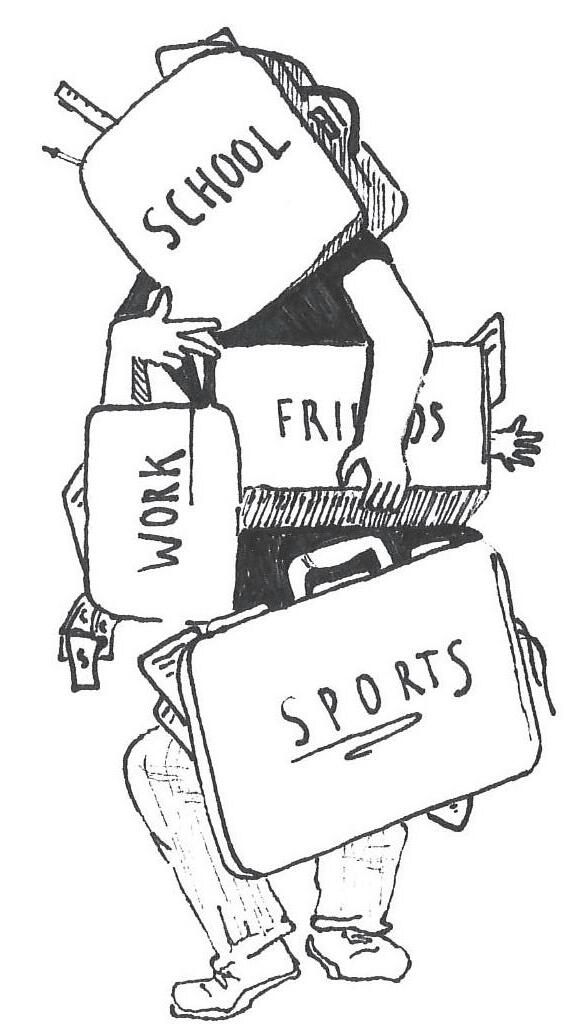
With an array of clubs, sports, and other activities one can select to occupy their time, “the competition” Zwart refers to exists on a nearly lim itless playing field. This can result in students’ feeling the need to over-in volve themselves, subsequently being “stretched too thin,” or, unable to put their best foot forward due to hav ing to take care of such widespread responsibilities.
“High school offers so many dif ferent extracurricular programs that it almost seems wasteful to not take full advantage of all that’s offered,” said Ian Miles (‘19), a current top ten student.
It was thoughts such as Miles’ that that once drove me to take on a full schedule outside of academia, but I quickly lost sight of my mental health as a result.
“The immediate effect of taking on too much is [figuring out] how you can still be your best self,” said Jason Baker, one of the high school’s student counselors. “If you keep working all the time, you’re going to burn out.”
Looking back now, it is easy for me to see such a burn out in the works during my junior year. The girl pulling all nighters only to then get to school forty-five minutes early for a meeting was not her best self; in fact, I was very far from it. But since extracurriculars are rarely seen as having the potential to be harmful to one’s mental health, I shrugged off the idea of dropping a club or activity in fear of looking like I couldn’t handle the pressure..
On a personal level, I excused my growing distance from all the activities I once loved with the fact that junior year was “supposed to be” hard, something I had been hearing since the day I entered high school.
“School is a generally stressful time, especially in the later grades,” said Miles, adding, “but I think most people expect you to do at least something [outside of class]. Taking on a lot can teach students to better manage their time, but too much can also overwhelm and stress people out.”

Though time manage ment is one of the notable benefits of extracurricu lars, it is also often where students begin to see negative repercussions. “You can tell who’s taking on too much,” said Baker. “Even if someone hasn’t identified this yet, it’s no ticeable. Finding a healthy balance of extracurricu lars is important towards not sacrificing your own mental health or emotional well-being.”
Though in the cases of many high schoolers, it can be hard to scale back, even when a healthy balance has long been left behind.
Yasmeen Gunandar (‘20) touched upon one of the main reasons for this: college. “There definitely is a lot of pressure in doing a lot in high school and I think it comes from applying to colleges since they are looking for people who are [participating in] extra curriculars.”
Gunandar’s ideas mirror those of many students, my over booked self included. I was so convinced that colleges wanted to see me do it all that I completely lost sight of what many extracurriculars are supposed to be about: fun. Activities I had once loved participating in now felt more like chores, which just added to the pressure I was feeling every time another club or sport meeting rolled around.
Like in Gunandar’s thoughts and my experience, Baker has also noticed a trend in students taking on busy schedules to look good to colleges. Although, he noted that taking on few activities over many may actually be key to both success and happiness. “People take on more and more things because they think that the more they have to promote to a college, the better,” he said. “But I really believe that it’s more about
quality over quantity in the activities you choose. Colleges want to see that you can take things on, but only if you can really invest yourself.”
Zwart seconded this notion, advising, “do what you can, and invest yourself in whatever you choose, but remember to do it for the right reasons. Pick extracurriculars that actually interest you, not that are simply ‘application boosters.’”
As for deciding on which activities to pursue, looking past college may actually be the most beneficial for personal growth, and the key to ensuring students are not being stretched too thin.
“Constantly evaluate where you are while keeping in mind what your goals for the future are,” said Baker. “As you’re evaluating, make the best choices you can in the moment to put yourself in the best position possible with courses and extracurriculars.”
This evaluation of future goals ended up saving me late in my junior year. After being spread across so many clubs that I was unable to meet all the time commit ments expected of me, nearly all the enjoyment I had once experienced had been replaced with stress. Thinking of facing another four years of the same pressures in college only amplified this, which is when I knew things had to change if I was to con tinue being able to enjoy school and the opportuni ties it provided outside of the classroom.
It was then that I made the decision to scale back by letting go of a few extracurriculars, and from it, came the first breath of fresh air from the neverending schedule I had pursued since freshman year. Though it was initially hard to make such a decision, I noticed my involve ment with the few activities I had left was actually increasing, giving me the meaningful connection that I had been missing while I was trying to achieve more than I could handle.
Since then, finding myself free of being stretched too thin has allowed me to enjoy extracurriculars again. Facing less internal pressures and stress has impacted both my in and out of school lives, leaving me happier and healthier than when I was overbooked.
In the words of Baker: “take on what you feel as though you can reasonably take on while still showing your best self, and remember that scaling back can sometimes be critical to putting your best foot forward.”
- Devan McClain Artwork by Demetrius Phofolos Photo by Devan McClainI remember sitting at the lunch table during my sophomore year, entranced by latest news about the relationship of a senior I had never even spoken to. I’ve heard of rumored hookups in the bathroom and of students getting themselves into dangerous situ ations with college kids, and while I acknowledge the absurdity of these stories, I’d be lying if I said they weren’t entertaining. Oh gossip, how we hate to love you.
When you think of gossip, you likely think of the rumors you’ve heard on your way to class, in the cafeteria, or passing through the halls. You might even have heard a story similar to the one’s I just described. Despite its bad reputation, not all aspects of gossip are necessarily negative. From a sociological and evo lutionary standpoint, gossip can even be a beneficial tool in forming social habits. Unfortunately though, in the adolescent years, gossip seems to serve one detrimental purpose: to bring others down. Whether you acknowledge the vice or deny all rumors that come your way, gossip affects us all: it’s just a matter of whether you’re a good gossip or a bad gossip. So which are you?
“Fundamentally, gossip exists because we are social creatures who need to live with each other to survive. Research psychologists typically define gossip as the sharing of evaluative information about absent third parties,” shares Michelle Leichtman, a professor of psychology at UNH.
The rooted dilemma that seems to affect not only Oyster River, but all high schools and most teenagers is that we (myself in cluded) just can’t seem to pull ourselves away from the toxifying “bad gossip.” We live in an era where everyone is vying for their 15 seconds of fame, and when sharing the secret you promised you wouldn’t grants that, it’s easy forget our better judgement. Gossip feels good.
Whether you’re getting an update or “spilling the tea,” unproductive gossip adds a new layer of stress and anxiety to everyday life when not only do you have to worry about the things happening in front of you, but what’s going on behind your back. Within small circles, sharing a juicy secret brings people closer together. Chloe Jackson (‘20) agrees that, “if you’re talking about a topic that you can connect on, then your friendship becomes stronger, but you’re also degrading the people you’re talking about.” What better way to bond than over a coveted piece of information? Within my own friend groups, I notice this rooted anxiety with in myself to hear what’s going on. Maybe it’s so I can feel connected by a piece of information, or maybe it’s so I make sure it’s not about me.
You may be compelled to “spill the tea” because it feels expected within your social circle. In larger settings like an entire school of 800 students, rumors are often entertainingly passed around because there’s no immediate consequence. “People just don’t have anything better to do. It’s easy, and most people can connect with it. There’s always going to be something to talk about. There’s al ways going to be someone who’s doing something different or something crazy that happened over the weekend,” says Kelsey Wiles (‘19).


After the high school years, gossip doesn’t deteriorate; it just matures. Brian Zottoli, a humanities teacher at Oyster River High School, explains that “Teenagers can be really mean, and they can be really critical, and they have a way of preying on weakness. Adults are just as petty; they’re just more refined in how they gossip. They don’t target the low hanging fruit.” In the adult world, gossip in the workspace can come across as slander and is seen as highly unprofessional.
Dr. Ryan Long, the psychologist at ORHS, connects the dots in this sense. “School is interesting for students, because it’s a professional environment for you, but it’s also your social environment. It’s both your friend groups and your workspace.” This is why gossip can seem heightened in high school, and when Oyster River is often referred to as “Oyster Rumor,” it makes sense why. Wiles adds,“There are eight-hundred kids in this school, how can we not talk about each other?”
Beside the obvious risk of hurting someone’s feelings, gossip can be unhealthy in the way of creating faces for people you don’t even know. Say a new student enters your grade. They seem normal and even friendly from the few conversations you’ve shared with them in your math class. But one day during lunch, you hear that they transferred schools because they got in a fist fight with a classmate and suddenly, the idea of pursuing a friendship doesn’t sound so appealing. “I feel like I know a lot about a person through gossip without having met them or talked to them before,” says Lily Doody (‘20).
“There are eight-hundred kids in this school. How can we not talk about each other?”
If we are taught that the act of gossiping and spreading rumors is typically mean-spirited, why do we continue to participate in it? “It’s ingrained. If you can throw someone under the bus which elevates you, then you’re in a better social standing and someone else is not. We have ways of targeting certain individuals to feel better about ourselves,” says Zottoli.
Insecurity is one of the greatest promoters of gossip and in high school. Sharing a piece of gossip is a quick-fix, a band aid to lift oneself up by bringing another down, which is why it’s often easy to risk someone else’s feelings for your own. The tongue is a sword and rumors like, “can you believe she cheated on her boyfriend?” tend to have no real productivity other than making the speaker feel better than someone else by bringing them down.
The gossip being shared doesn’t even necessarily need to be something that makes the speaker feel superior in comparison. I know that when I share a particularly good piece of gossip, there is an instant gratification from the positive reactions of my listen ers. It’s nice being at the front of the whisper process.
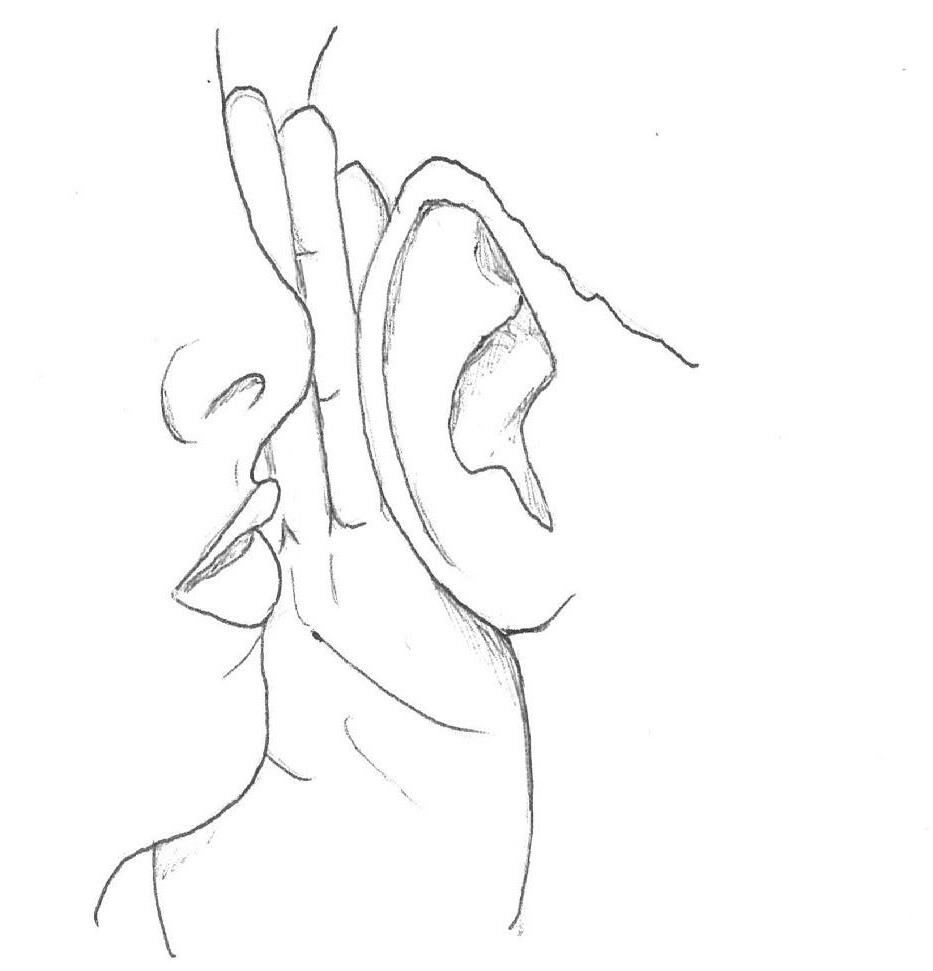
While gossip is somewhat petty and often frowned upon, not all gossip is created equal, and there are some arguments towards its favor. “Something important to distinguish is that every time you talk about someone doesn’t necessarily mean it’s gossip. It’s different when you’re trying to work out an issue with a friend or you’re venting,” suggests Wiles.
There are circumstances where gossiping can be beneficial and even healthy. For one, gossip can strengthen and solidify relation ships as it allows us to create and maintain social bonds with small to large groups of people.
Gossip can also create unspoken social cues and laws that can be examined from an evolutionary perspective. “Human beings need to make reputational judgments to determine which creatures (outside those with whom they have kinship relationships) to interact with and which to stay away from… One way humans can streamline the process of sharing reputational judgments is to talk about other people, and you can see why people receiving this information would pay attention to it; in some contexts, it could enhance survival,” says Leichtman.
The theory of “prosocial gossip” allows humans to learn from the consequences of particular social behaviors in order to make informed decisions about their own choices. A 2016 study conducted by Jan Engelmann published by the British Journal of Develop mental Psychology determined that, “already at preschool age, children spontaneously gossip and offer helpful reputational informa tion.” In this case, gossip is an instinctive process and even somewhat benefits our society.
In the best scenarios, gossip is simply a primitive social ritual that helped our early ancestors survive and allows us today to determine right from wrong. The prevailing issue is that, “she slept with him, what a slut,” is entirely different from hearing about the negative behaviors about a friend’s partner and using the information to teach ourselves how to be a better, more caring partner ourselves. Simply put, the juvenile gossip in high school teaches us how not to be talked about rather than how to be bet ter people. “Can you be your true self if you’re constantly just trying to be someone different so you’re not gossiped about?” Zottoli asks.
In a time period all about growth and the development of who we are as young adults, will we ever be able to fully come to fruition if we’re so preoccupied as to how we come off in other people’s rumors as long as “bad gossip” abounds? And while I don’t have any advice on how to break the habit, isn’t the first step on the road to recovery identifying the problem? If we truly feel the need to gossip, we can at least start by asking ourselves whether it’s “good”gossip or “do-good” gossip.
-Grace CastonguayAnd that’s the tea, sis.
I would imagine that the hardest part about being a parent is learning to let go, and trust that your child will be safe on their own. As children age and grow increasingly independent, some parents struggle with this concept and hold on tightly. In this day and age, children are highly accessible and are expected to be, whenever and wherever they go. Within a matter of minutes, parents can expect responses and updates almost instantaneously from their children. Now, with the cre ation of tracking and location sharing apps, parents can acquire the exact whereabouts of their child at any point in the day with out the need for a single text.
Although keeping constant tabs on your child may seem like the best way of protecting them, if a child grows up under 24/7 watch, will they ever truly learn what it’s like to survive in this world independently?
I’m here to tell you that it won’t. As hard as it can be to accept, the best way for children to really learn, is by making their own mistakes in life; I’ve observed this first hand.
I’ve met the parents who take away their children’s in dependence by simply being too involved in their child’s everyday life, the parents that inquire about their child’s where abouts through me, the parents who send bullet texts to their children every time they leave the house… these are the parents I am talking about. To the parents who simply observe and counsel their children through life, you can relax, this article isn’t about you.
As children progress into adulthood, there is a growing ex pectation for an increase in freedom and leniency from parents. I urge parents to welcome this change, as it will only benefit your child in the long run.
With the new development of location sharing apps for cell phones, parents can track and know the exact location of their child at any moment. 24 hours a day, 365 days a year, anywhere possible on the planet, your parent will know where you are, and where you’ve been. This doesn’t have to be a bad thing, in fact it can be used as a safety precaution. The problem starts when par ents use these apps to keep constant tabs on their child. The lack of independence here is what creates a question around the value of trust between any parent and their child.
Speaking from personal experience, trust in any relationship is essential to developing an understanding and respecting bond between yourself and others. I believe that when it comes to parents and children, if you choose to trust in your child to be safe and responsible for themselves, you are acknowledging their strength and ability to be an adult.
Trust is something that develops through trial and error, but these trials can only be instigated by the parent, not the child. The parent decides when to release control of their child, which is why I encourage every parent to do so. It’s a gradual and time
consuming process, but it is one that needs to happen nonetheless.
“When I am out with my friends, my mom is constantly tex ting me to make sure I am alright, and if I don’t respond to her within a half hour, she gets worried and sends me more texts,” explains Lauren* “It makes me feel like I am constantly needing to text my mom when I am away from home to let her know I’m still living. I understood when I was younger, but now I am 18 and I feel like it is a little much considering my age.”
What Lauren is describing is what’s known as an “overpro tective parent.” As I said earlier, parents commonly exhibit an unwillingness to let go of their child, which is entirely under standable. The job of a parent lasts a lifetime, and as a parent you’ll always want your child to be protected. However, overpro tection only creates a bigger issue, and actually hurts the child’s development rather than nurtures it...
Overprotective parenting is sometimes referred to as “helicop ter parenting.” Helicopter parenting is meant to categorize the type of parent who is constantly watching over their child, and in some cases controlling them entirely. This term provides a tight rope to be carefully walked upon and navigated by other parents who may fall under the words themselves at one point or another.
“Helicopter parenting is not what I think helps teens or chil dren learn to be independent, responsible, and safe on their own. It just means that you’re constantly being watched and that way, you don’t have to be responsible for yourself because somebody else is doing it for you all the time.” says Child Development teacher and parent to two ORHS alum, Laurie Grant.
Helicopter parenting is distinctly different from, well, parent ing. A parent will worry about the safety of their child, and do what they can to put them in the best position to brave the dan gers of the world on their own. A helicopter parent will control this process, rather than enforce the stability of it. This gives little control (if any) to the child.
“If [parents] were always checking in on you all of the time or if they always want to know where you were, and they were constantly questioning what you did and why you did it, that to me is helicopter parenting and not just making sure you’re safe. I guess that’s the difference,” explains Grant.

There’s also the newly developed term, the lawnmower parent. This is the parent who removes obstacles for their child, to make their child’s life easier. Berating teachers to improve grades or switching your child out of classes where their friends aren’t are both examples of how NOT to deal with problems life naturally provides, and both things a lawnmower parent may do; This is just another way of giving temporary aid while creating a long term issue.
This may sound like a bias point of view considering my age (17 if you’re wondering), but parent’s can attest to this theory.
Tarra* describes her feelings as a parent, explaining, “it’s nev
er fun to see the hurt in your child when they lose a game or fail a test but it only makes them learn that life isn’t always going to go in their favor and that makes them work harder for the next time.”
When parents use apps, such as the location app Life360, it is not just because they don’t trust their children. It is simply used for a parent’s peace of mind, to know their child is truly safe wherever they may be. After all, isn’t that the responsibility of any parent?
“[Looking out for one another] is just what families do. We look out for each other, and aren’t we so lucky that we have this app in this day and age that helps us make sure that our kids are safe,” ex plains Grant. “It’s not just about your parents making sure you are where you say you’re going to be. It’s also about, if you don’t come home when you’re supposed to come home, then they can find out where you are because not knowing at all is just scary.”
Location apps are generally only used out of concern for safety, and there are plenty of benefits to using them.
My dad only downloaded the app, Life360, onto my phone when he saw a news story about a teenager’s life being saved by it. My parents don’t track me constantly throughout the day. They rarely even check the app to see where I am. But if they ever did need to find me in an emergency, they’d know where I be, and that is pre cisely how the app should be used.
“It’s great to see if your child made it to school in bad weather without having to text them or see if they are on the road so you know not to text but to call them instead if you need to contact them. It also has crash detection and will notify any of us if a fami ly member is involved in a crash. There are options you can add on and purchase which show a report on fastest speed, phone usage, etc.,” explains parent to an ORHS student, Tarra.

The problems begin when parents start to walk the line between protection and overprotection. There’s the parent who tracks their child’s location for safety precautions, and then there’s the parent who needs to be updated constantly either by the location app or the child themself; that’s when you know you’ve crossed the line to helicopter parent.
Every parent is different, and each one will have their own set of rules and expectations of their child. Everyone has the capacity to make mistakes, because that’s just the way life works. My belief is that mistakes are needed for proper development. Although it may be scary, sometimes kids need to have the ability to trip and fall if they are ever going to learn how to pick themselves up again.
My parents have always provided a safe environment for hon est communication. Through time and with experience we have grown a bond where they know they can trust me, and thankfully for this, I have become a self sufficient and functioning person in the world.
I understand that developing this relationship is a time con suming process of growth and development, but I believe it is necessary for any parent/child relationship. There will be mis takes but you learn from those experiences and you mature from them. Mistakes in life only provide room for growth, and it’s my belief they should be accepted and not avoided.
This understanding will allows for more peace of mind for the parents too! My parents know I’ll be safe, because they know they can trust me to be independent and to take care of myself.

“I know of parents who read all their kid’s texts every night or check their social media at all times, and while I understand some parents think this is smart in the crazy world today, I don’t agree with that method,” says Tarra. “I wouldn’t feel right being involved in their personal world like that. I compare it to the old school diary. I used to have a diary I locked up. If my parents had read that, it would’ve broken our trust.”
The issue of the overprotection vs. the underprotection ulti mately boils down to there being a parent vs. child conflict that’s not actually needed. Parents, it falls on you to decide what’s best for your children, but I am asking if you really believe nurturing your child into adulthood will truly prepare them for the world.
“My parents take my phone at 9 p.m. every night, and whenever I go out with friends I have to be home by 9 and I have to leave my location on,” explains ORHS student, Steven*. “They have gotten better about it, but it still feels like I’m living under a rock some times,” he says.
It is entirely necessary that the child earns their freedom. Just as I said earlier, you earn trust. Afterall, I said that this process took time and effort, and not all of that falls onto the parents. The child also needs to prove they can in fact be trusted with more responsibility.
Trust is not simply an expectation but a right granted to those who prove they can retain and follow it. Once you have the trust of your parents, freedoms are generally granted and the many texts that were once sent to your phone every time you left the house, now begin to minimize in volume time and time again.
“We all want to protect our children from all the bad stuff in the world and letting go is one of the hardest parts of being a parent, but we really need to ask if we don’t let them experience failure or heartache how will they survive on their own in the world?” explains Tarra when addressing parents di rectly. “We need to instill respon sibility, courage, and self-esteem in our children. That can’t be done if we overprotect or smother them.”
Trust can be tested. For any par ent who is not ready and willing to place all trust on the table, small, ba sic and easy steps are a good place to start. Placing a little responsibility on a child here and there can eventu ally lead to a much more substantial difference. And one day? They will have earned that trust. And letting go won’t be so difficult anymore.
-Anna Sourdif By Audrey Ammann*Names have been changed for anonymity

“I knew Tinu would change the world for the better, but didn’t realize the impact he had already made,” says Kayla Wark, Tinu Afolayan’s former teacher.
Tinu Afolayan (‘20) is arguably the band OKGo’s number one fan. He discovered OKGo in middle school and fell in love with the group and their music. Since then, watching the band’s videos has been both a hobby and an educational resource. As a student with Down syndrome, Tinu’s academic curriculum has been greatly improved through music and dance. After learning about Tinu’s experience with OKGo, the band was inspired to create the Sandbox Educational Program, a website with educator guides to lessons using the band’s music videos.
On Friday, November 2, Tinu put on his grey sweatpants, yellow shirt, and red OKGo sweatshirt in preparation for the big night.

A few years ago ago, while scrolling through Youtube, Tinu came across an OKGo music video called “Here it Goes Again,” where the band sings as they dance on treadmills. Tinu loved it right away. According to Down Syndrome Education International, people with Down syndrome experience learning difficulties that lead to delays in some areas of development. It is often more useful to learn through mediums like music and art than tradition al teaching methods. Research suggests that learning can be improved when people with Down syndrome can use visual sup ports. And according to Nature Reviews Neuroscience, a leading review journal, “musical experience strengthens many of the same aspects of brain function that are impaired in individuals with language and learning difficulties.”

For Tinu, OKGo has been the best resource. “They are goofy, theatrical, innovative, and resourceful in the many ways they organize and put their shows together. At the same time, they are also meticulous, detailed, and unusually focused,” says Tinu’s father, Dr. Funso Afolayan, on what Tinu likes about OKGo.
OKGo formed as a quartet in Chicago in 1998 and relo cated to Los Angeles three years later. The band is composed of Damian Kulash (lead vocals, guitar), Tim Nordwind (bass guitar and vocals), Dan Konopka (drums and percussion), and Andy Ross (guitar, keyboards and vocals). The rock band is best known for their creative and often low-budget music videos,
many of which have gone viral. Their lists of awards and nominations is impressive. In 2007, “Here it Goes Again” won a Grammy award for Best Music Video. Check out the band’s Youtube channel to see their work https://www.youtube.com/ channel/UC194cPvPaGJjhJBEGwG6vxg.
Tinu’s middle school teachers, Wark and Jackson, shared Tinu’s opinion on the band and, “soon came under the OKGo spell. They seized the opportuni ty to explore the potenti alities of the OKGo videos to improve his school curriculum,” Afolayan adds. Wark found that incorpo rating the music, videos, and information about band members led him to accomplish more academi cally and be more engaged in class than he ever had before. He would practice his handwriting by filling in the blanks for lyrics and was motivated to read in dependently for the first time when Wark made a short book with pic tures and information about the band. Afolyan says, “over time, Tinu, who is usually reticent in speaking, was able to memorize most of their songs, articulating the words clearly and effectively. Watching the shows, mim icking the music, and singing along have combined to remarkably improve his word enunciation and speech.”
OKGo didn’t plan for their videos for the classroom environment, but they were wonderfully surprised a few years ago to discover how large a role they had played in educa tion. Damian met with Dr. AnnMarie Thomas, who leads the Playful Learning Lab at the University of St. Thomas, and brain stormed ways to support classrooms. Within just a few days of posting a survey to ask edu cators for their ideas, nearly a thousand teachers sent their thoughts. OKGo
has been partnered with the University of St. Thomas and Playful Learning Lab since, collaborating to create the Sandbox Education Program. The free website has embedded educator guides that include material lists, assignments, and suggested vocabulary words. They use their videos, which involve many STEM topics, to engage students in learning and have created challenges that address science and math competencies. Teach ers from Kindergarten to College alike are able to use the videos, and the band hopes to continue to grow the program to spread these tools with educators across the country.
Cathi Stetson, the computer science teacher at ORHS, uses music and other forms of art to have students create something with terminology in her pro gramming class, and believes that programs such as the Sandbox are essential to teaching. She picked music as a way to remember things because music is an important part of how we learn and how we remember. “We are taught rhythms and patterns at a very early age...think of nursery rhymes or even our phone numbers. A pattern of 3-34,” Stetson says.
She feels that interactive lessons are extremely important especially for the visual learner. She says, “not everyone can or every school can participate in field trips or science experiments and the use of technology has opened up a whole new world.”
Damian spoke to National Public Radio about the band’s use of technology to spread educational videos, saying, “the universal thing we’re trying to get at is just curiosity and wonder. That excite ment about the world, where you want to uncover something magical.”
In addition to academic benefits, intro ducing Tinu to OKGo brought him out of his shell in many ways. According to Wark, the band serves as a conversation starter for Tinu; he is eager to share videos with peers, teachers, and family, and he has even brought posters to church to share with people. “For Tinu, OKGo is a passion that brings him incredible joy. He turned many peo ple at Oyster River Middle School into big fans as well!” she says.
Wark put together a video with pic tures and clips showing how much of Tinu’s day involved OKGo. “I feel like Tinu brings so much joy, laughter, and happiness to other people’s lives and wanted to try and do something special for him,” she says. She also wanted the members of OKGo to know how important they are to Tinu.
Doug Young (‘20) has
known Tinu since elementary school, and helped recreate one of OKGo’s dances for a part of the video. “It took a long time to learn the moves and memorize them all the way through the song. Our main goal was to recreate the music video as much as possible with the resources we had,” he says.

The band responded with videos of the lead singer, Damian, and bass guitarist, Tim, talking to Tinu and thanking him for the video. “Damian was holding the laptop in the video with Tinu’s video paused, and Tinu LOVED seeing himself and Damian in the same frame,” Wark says. A few days later Tinu received a package with all of the band’s merchandise -- a sweatshirt, tote bag, several CD’s, a DVD, a book, poster, and more.

The band wanted to meet Tinu but weren’t touring anywhere on the East coast at that time. So when Wark got a facebook notification this past summer that OKGo had an upcoming concert in Boston, she immediately reached back out, unsure if they would remember them from a few years ago. The band remembered Tinu well, and that’s how the experience at the concert was made possible this past November.
“It took Tinu a few seconds to realize this was real and that here in front of him are the band members in flesh and ready to greet and play the drums with him. For much of the show, he was on cloud nine,” says Afolayan.
The band secured tickets for Tinu, his family, Wark, and Jack son, right after contacting Wark because they were selling out fast. Tinu and his family arrived at the Berklee College of Music Performance Center in Boston a couple of hours before the show on Friday, November 2 to hang out with the band during sound check.
The concert was part of their “video tour” so the music video to each song played on a screen behind the band as they per formed the songs live on stage, which was particularly exciting for Tinu. Tinu sang and danced along to each song, and loved every time the confetti cannons went off. He kept saying, “what a mess!” as the colorful paper sprinkled down on floor. “The band invited all kids in the audience to get up and dance in the aisles for the encore. Tinu has a blast and showed off his moves for everyone--- I think we can confidently say he was the biggest fan there!” says Wark.
After the concert ended, the venue emptied and someone who worked for the band came out and brought Tinu’s group under the stage where it was just the band, their families, and friends. They had the opportunity to hang out more with the band mem bers, take some pictures, and even exchange contact information with both Damian and his parents to keep in touch.
After the concert, while under the stage with the band, Dami an’s mother asked Wark if she knew that the Sandbox Education Program was inspired by Tinu’s video. Wark felt so proud. She says, “it is extraordinary to me that one young man and his pas sion for all things OKGo has lead to something so much bigger.”
by“Tinu brings so much joy, laughter, and happiness to other people’s lives and wanted to try and do something special for him”
-Kayla Wark
-Phoebe Lovejoy
Photos
Kayla Wark
As a freshman, I walked into Kim Sekera’s counseling office for my first high school schedule meeting and immediately noticed the pictures of her family and the Tibetan prayer flags that lined her walls. Not until my senior year did I notice a first place plaque displayed on the corner of one of her tables, and numerous medals pinned up on her bulletin board. Students are used to seeing the friendly, professional side of Sekera, but there is another aspect of her life that many do not know about: Sekera is an avid, nationally ranked triathlete.
As I asked her about her experience as a triathlete, her face lit up, especially when she discussed the exercise, the competition, and the connections she has made with the triathlete community. After recently placing in the top three at the Long Course Nationals in Miami, Florida, Sekera excitedly explained how she has been offered the opportunity to represent the United States at the World Championship in Spain.
Sekera described herself as “very excited and proud as I met my ‘dreamy goal’ to get top 3.” Her husband, Jayson Seaman, noted: “I am very proud of her [Sekera]; her hard work paid off with her accomplishment at the National Championships of coming in 3rd in her age group.” He added, she is “very dedicated and committed to her training. She rarely misses a workout.”
Sekera has realized that her dedication to racing translates well as a high school counselor. “I often talk to students about future goals, whether it’s academic, career, athletic, or other goals. This relates nicely to conversations with students about not only goal setting, but also that students don’t need to know exactly what and/or who they want to be before they graduate from high school.” She added: “we discover new skills and passions throughout life and finding the courage and passion to pursue them is admirable regardless of when you discover them.”
Not only does being a triathlete help her as a counselor, but it also provides her with an outlet outside of work. Sekera beamed while explaining other main reasons she loves to participate in triathlons. “Part of it is exercise. For me, it helps me decompress. I’ve also always been one to take on challenges and push my limits physically. I used to be an avid rock climber and white water paddler, but now with kids, I don’t have time to do that as much anymore. Triathlons are my new adventure and challenge,” said Sekera.
Ever since Sekera started doing triathlons in 2012, she has taken part in a wide variety of competitions, all of varying distances. She first started competing in Sprint Distance (see infographic on the next page for further details on distance of swim, bike, and run) and then in Olympic Distance triathlons, and has worked her way up to Half-Ironman Distances.


“For Sprints, it’s over faster, but in some ways, they’re harder because you are redlining it the whole time. You are only competing for roughly an hour or two. Whereas, the Olympic is a little bit longer, and then the Half-Ironman distance is not redlining the whole time; you are pushing, but not going all out, which I really liked.”
After competing in various triathlons and getting the feel for different distances, Sekera has now focused her attention on Half-Ironmans. After her first Half-Ironman, the Timberman Triathlon, in Gilford, New Hampshire in 2015, she realized how

much she enjoyed it.
“I love the endurance piece; I like going out for a nice long run and being on a long bike ride.” She continued, saying, “I love the sense of accomplishment at the end knowing that I just did a five hour long race. That feels exciting! I would definitely say there’s some strength there in that.”
Because triathlons are multi-sport competitions, they require intensive cross training. To help with the training process, Sekera has a coach from Peak Triathlon Coaching (PTC), Karin Biskovich, who creates a specific individualized training plan for her.
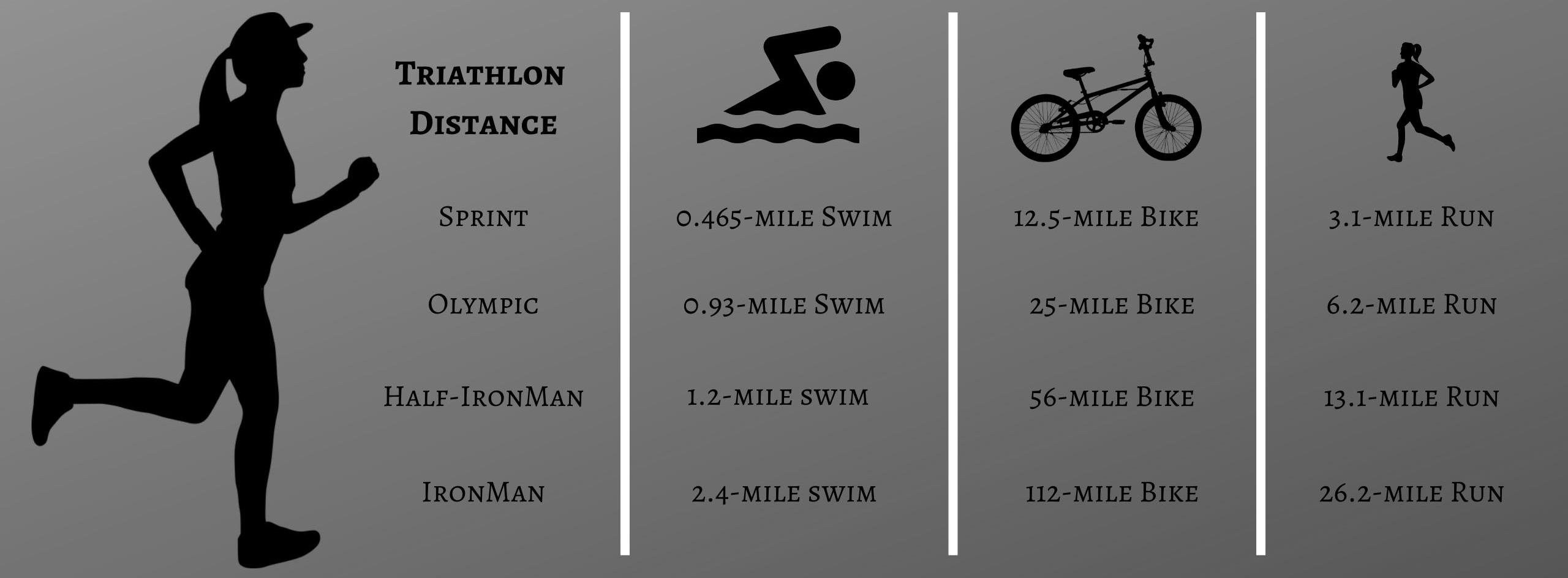
Biskovich detailed how she and Sekera work well together as they are both excellent triathletes and, “since we are both working moms and triathletes, I think she felt we could work well together to come up with a program that worked best with her busy schedule.”
Prior to working with a coach, Sekera said that a lot of her training, healthy eating, and proper fueling techniques have been self-taught, with the help of her husband, who also is a triathlete.
Together, they trained and competed at the Long Course Nationals. Unfortunately, Sekera’s husband did not place because he broke his collarbone in a bike crash during the race. Prior to the race, Sekera and her husband made an agreement that they would only go to Spain to represent the United States if they both qualified. Because of this, Sekera might wait to advance on until her husband can go with her.
In order to progress this far as a triathlete, Sekera also mentally prepares for Half-Ironman Distance triathlons. Sekera highlighted that, “five hours of straight exercise is a lot of hard work and it’s a lot of quiet time in your own head where you can either psych yourself up or get tired, fatigued, or discouraged. Trying to stay positive and motivated in those moments is important.”
Although racing requires extensive training and extreme dedication, Sekera believes it is worth it. “It gives me a runner’s high and keeps me mentally and physically healthy just because it’s a break from work. It’s great to just zone out and go for a run or be on my bicycle. It’s a great way to clear my head.”
Because of her hard work and commitment to the sport, Sekera humbly explained how she has received some overall podiums at local races and has even placed well at large HalfIronman Distance races.
Along with the sense of accomplishment, Sekera loves the community of triathletes. “When I go to triathlons, it has this sort of community feel that not a lot of other sports necessarily
have. It has this sort of comradery to newbies,” said Sekera. With more experience as a part of the triathlete community, Sekera is no longer the newcomer. “I was welcomed to the community and now, I am helping and encouraging others when they’re nervous.”
Because of this, Sekera has formed connections with other competitors, especially through the triathlon team that she is a part of. “I have formed a lot of friendly connections through racing. In particular, through SIX03, I have met a lot of people that I would not have met otherwise. I also now see a lot of familiar faces at races and have fun little bonds with them.”
Dawn Cobak, who is a member of SIX03 and one of Sekera’s teammates, said, “[Sekera] is incredibly helpful, and she knows more about racing as she has been racing longer than I have. Her best quality, though, is how supportive she is on the course while we are racing. She always smiles and waves, even when she is busting out 6 minute miles on the run or 26 miles per hour on the bike.”
Not only does she have accolades from her peers, but from local sponsors like Philbrick’s Bike and Ski as well. She mentioned: “Philbrick’s, as our local bike shop and a sponsor of SIX03 and their whole team, especially George Philbrick and Megan Cushman, have been so good to the triathlon team, but especially to me and my family.”
Sekera’s positive and outgoing confidence has allowed her interact with former triathlete Olympian, Sarah True, at the end of one of her favorite races in Canada. Sekera said that because Half-Ironman races are so intense, she has competed on the same course as professionals.
Sekera hopes that she will be able to continue to have more astounding conversations like she had in Canada at Ironman Mont Tremblant, deepen the friendships she has created with her teammates, and continue to fulfill her goals as a triathlete.
This passion will also allow her to continue to be successful as a school counselor. Kim Cassamas, another ORHS school counselor, said, just like students are taking on responsibilities outside of school, “she balances work, being a parent, wife, and triathlete. This is no easy feat and she is an inspiration that if you want something—you can make it happen with the right support in place and right mindset. This is an important message for students to always know.”
- Abby Schmitt Photos by Gameface Media“Going into my senior year of high school, I had committed to Duke two years prior. I was used to being on top of the world because of soccer. I was used to it being my everything, I was used to being known for it. I was proud of it.”
From a young age, Abby Pyne found a passion in soccer. She remembers that her hometown of Dixmont, Maine didn’t have a youth team for her age group, so she sat on the sidelines while her older sister played. Pyne said she began competing when, “one day, someone got hurt and they were down a player, so I got to go in. I knew this was the best day ever.”
As time progressed, so did Pyne’s prowess. Since her freshman year, 6’1” Pyne dominated between the goalposts every fall for her high school varsity soccer team in Bangor, Maine. Her presence brought accolades, including the All-American and All-Regional Honoree, a three time All-League and All-State title, plus the Maine State Championship four years in a row. Her performances on the high school level didn’t go unnoticed as she both played for the US Women’s National Team from ages 12 through 17, and received a full scholarship to Duke University. TopSoccerDrawer.com ranked Pyne as a top ten goalkeeper before she had played a game for the Blue Devils.
Her promising career would soon come to a close, as a knee injury in the summer before her senior year would begin a chain reaction of impairments on both of her legs. Eventually, she would lose soccer, and be forced to shift away from what she had previously thought to be her career.
During a goalkeeper camp in prepa ration for the U19 women’s national team, Pyne experienced the combi nation of an impact injury and an overuse injury which crippled her left knee. “I remember walking into the doctor’s appointment. The doctor pulled up my MRI and said, ‘you’re going to wish you had an ACL.’ He explained to me that I had knocked off a chunk of cartilage under my left kneecap, so every time I bent or flexed my knee, or put any weight on it I was driving a ton of force straight through my kneecap, which was now down to the bone.”
Her first surgery required a 12-18 month recovery, which meant Pyne wasn’t able to play going into her freshman year of college. She sat out the DI NCAA season during the fall, before training during the spring of her freshman year. “A week and a half before preseason of my sophomore year, I thought I was going to land a starting spot. My knees blew up again, and whereas previously it was concen trated on my left knee, this time both blew up.” After getting her MRI’s done, her surgeon, Doctor Alison Toth, informed Pyne that she needed extensive knee surgery on both legs.
After working in rehab for two and a half years on her prior surgery, Pyne decided she wouldn’t get the surgery done. With
her sophomore preseason about to start, doctors did a series of three in jections on each knee. In order for her to get to a point to play, her doctors regulated the amount of training she could do since she didn’t have the abil ity to run. Pyne was practicing for her team, however much of the soccer she was allowed to play was heavily mon itored and restrained. Despite being regulated by her doctors, she did play competitively games for the Duke var sity team.
In her second season as a Duke play er, the girls soccer team qualified for the NCAA tournament. Before the round of 32, another tweak of her knees resulted in a bilateral MRI. The team was about to go on an away trip, so all the players were downstairs in the locker room of the training facil ities. Pyne recalled that, “my athletic trainer called me upstairs, saying that Doctor Toth is here to talk to you. I went upstairs to see a ton of people in the training room after this ominous call. They take me to this back room before [Doctor Toth] pulled up my MRI’s and showed me the cartilage graft on my left knee had failed, so the cartilage was entirely down to the bone. Kneecap was breaking because there was no cartilage to support it.”
After Toth showed Pyne the MRI on her left knee, which was injured beyond repair, she switched to the MRI her right knee, one that previously appeared to be less

of an issue. “It almost seemed to be worse than my left knee,” Pyne said. Toth explained that the only surgery available to Pyne was an ACI (Autologous Chon drocyte Implantation), which extracts and uses the cartilage producing cells in your body as a base to expand into cartilage for implantation. Since the 12-18 month surgery was required for both knees, the surgeries would have to be stag gered in order for her to bear weight.
Toth then clarified, “this is it. This is career ending.”
There is no surgery now that fully heals cartilage.
Pyne underwent the bilateral scope, the first part of the ACI surgery, and recovered in 21 days. She began practicing with the team before the Elite Eight of her sophomore year. The team lost in the national championships in Decem ber. Pyne then had another surgery on Christmas Eve her sophomore year in an attempt to fix the cartilage defects under her knee. This surgery also required her tibia to be cut in half and repositioned. A year and a half later, after her left knee had healed sufficiently, she received a similar cartilage replacement and tib ial reconstruction on her right knee.

Abby has had eleven knee surgeries total, eight on her left knee and three on her right. Three major operations took twelve to eighteen months to recover, and she has spent roughly six years rehabbing from her surgeries. In total, Pyne played three competitive games for Duke.
From losing the NCAA championship, to getting a massive knee surgery, the spring of Pyne’s sophomore year was difficult for her. She described how she, “was just trying to figure out and find a new passion. I had gone my entire life with a very singular passion that was entirely dependent on my body being able to function.” In addition to playing soccer at Duke, Pyne also coached for their summer camps. Through soccer camps, she met and became close with a young girl who eventually was diagnosed with cancer. Pyne frequented the hospital to see her and through these visits, realized she loved working with children in the hospital. She began to work through volunteering hours to expose herself to the positives of Duke Hospital and what Duke Athletics was possibly lacking.
Pyne worked with the staff at Duke Hospital to set up a program through athletics to bring other Duke athletes to the children’s hospital. “It was an awe some program that helped me to figure out my new passion, which was the hard est emotional part [of losing soccer].” The arrangement of Athlete Wednes days, which was propelled by Pyne’s surgeries and athletics, culminated into her current medical major. “Being able to fix myself emotionally by channelling my emotions into a new passion was how I got through that.” With similarities in medicine and athletics, Pyne found it easy to transition from one to the other. She stated that, “with the discipline it requires, the teamwork it requires, the never-stop-working mentality, where you always have something to learn, the two are alike.”
Pyne is now working on her graduate studies at Columbia University study ing Health Sciences, and is on track to begin medical school in 2020. She is also researching patellar cartilage defects at the Hospital for Special Surgery, working with patients similar to herself, with knee cartilage problems. She em phasized that, “my journey, while filled with pain and setbacks, has brought me from relying on my body to relying on my mind, and from playing for others to simply helping others.”
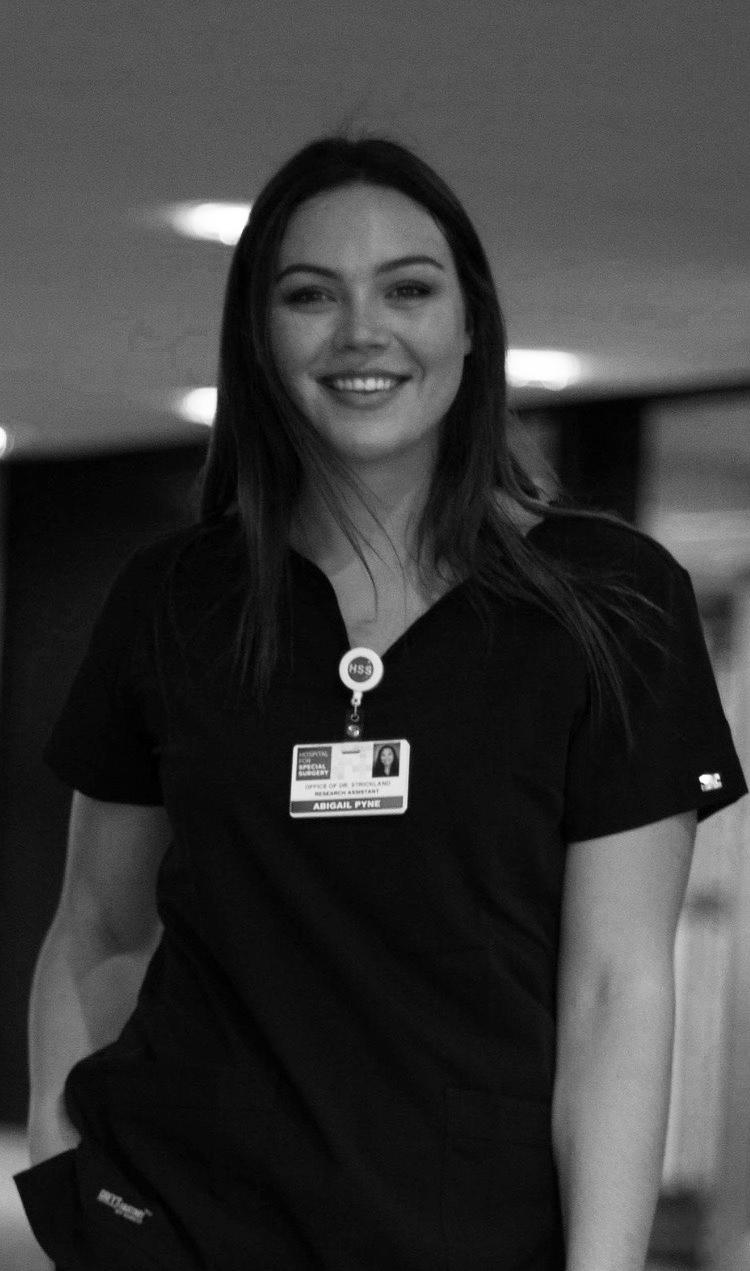
Her medical career means more to her than her former career in sports. “While athletics provided me the chance to inspire others, medicine allows me to be able to directly change someone’s life,” Pyne concluded.
- Quinn Wilson Photos by Sandra Wilson PyneTim Peterson, the Senior Editorial Analyst and Producer at New England Sports Network (NESN) believes, “fandom is handed down, father to son, mother to daughter. The longer period of time that goes on, the more entrenched it gets, the more passion it gets. I think that is the main difference between a fan of Boston, and a fan of another city.”
In February of 2002, the New England Patriots won their first Super Bowl title in franchise history led by a young quarterback named Tom Brady. In 2004, the Boston Red Sox ended an 86 year World Series championship drought, known by New Englanders as the ‘Curse of the Bambino.’ In 2008, the Boston Celtics won their 17th title, their first since 1986. And in 2011, the Boston Bruins defeated the Vancouver Canucks to win their first Stanley Cup in 39 years.





New England teams have won 11 championships since 2001. Five from the Patriots, four from the Red Sox, and one from both the Celtics, and the Bruins. The fans of these teams are witnessing arguably the greatest two decades in the history of New En gland sports. How have New England fan’s attitudes changed towards their favorite teams? How will they change in the future? Are New England fans different than fans of other cities? Why do New Englander’s don the jerseys of their favorite players all year?
A region of six states, New England has a professional team in each of the four major leagues (MLB, NBA, NHL, NFL). Addi tionally, the New England Revolution in the MLS and minor league affiliates.
Winning draws the attention of old and new fans alike, and when New England teams are consistently winning championships, all fans are impassioned. With a plethora of successful teams to watch, fandom is ingrained year-round throughout all of the North east. However, there is not just one type of fan tuning in.
“You have three types of fans. You have the blue blood fan, who has been a fan since they landed at Plymouth Rock. They will always be a fan and will continue to root for their team no matter how good or bad they are. Then, you have the fair-weather fan who pops on when they’re really good. They will come and go. Then, there is the third fan, the pink-hat as they’re so labeled. They’re the ones who are even more fair-weather than the fair-weather fan,” says Peterson, who grew up a fan of New England sports in Maine, and has worked at NESN since its founding in 1984.
The 2018 Boston Red Sox won the World Series after having their greatest season in franchise history. As Peterson describes it, the blue blood fans are the ones who followed the team closely in the offseason, and would have ambitious hopes of a championship before the season started. The fair-weather fans tuned in around June or early July when they realized the Red Sox were in the midst of something special and were no longer just having early season success. The pink-hat fans tuned in sometime during the playoffs when it seemed everyone around them was talking about it, and so they joined in too.



“I use the saying: as long as they’re under the umbrella, who cares how they get there?” says Dale Arnold, a NESN broadcaster, who is the only person to have called play-by-play for all five New England professional sports teams. He believes that no matter what the fan’s dedication, they’re still a fan and their support is welcomed.

“It’s a way of life here.”
One of the driving forces of fandom, has been the ability for fans to watch games consistently. Peterson explains that the 24 hour sports network, NESN, has allowed fans to watch every Red Sox and Bruins game, minus a few national tv exceptions, and get constant coverage of their favorite teams. A luxury many other cities have yet to be afforded.
Arnold, a Maine native and New England sports fan himself, whose career in tv and radio broadcasting is approaching 40 years, describes the biggest difference between fans of New England teams and other cities as the intense passion they have for their sports.
New England fans are notoriously passionate, loyal, and unforgiving. From the Royal Rooters club, a infamous Boston Americans (changed to Red Sox in 1908) fan club in the early 1900’s that is now known as Red Sox Nation, to the national holiday feel that comes with each time the Patriots play.


Historically, New England fans are pessimistic. They hope for the best, but they expect the worst. Prior to these most recent two decades of success, fans maintained an attitude that however good the team was, they would find a way to not win the most import ant game of the year, the one that would give New Englander’s a championship to celebrate.
“Ten to fifteen years ago, the typical New England fan’s attitude would be, ‘oh we’re a real good team, but how are we going to screw it up’... now there’s more of a confidence that the team will figure it out,” says Don Maynard, an Exercise, Physiology, and Wellness teacher at Oyster River High School and lifelong Boston sports fan.
There is a well documented history prior to these past two decades, where New England fans, even when their team’s were doing well, thought that failure was inevitable and unavoidable. Not because they always wanted to be constant downers, but because their teams weren’t having anywhere near the success they are today. Too many times, New England fans had their championship aspira tions crushed by failure, and misfortune.
To back up Maynard’s view of today’s New England fan, ORHS student Max Lewis (‘19), who has been a fan of New England sports for his whole life, adds, “[even when they’re bad] they always seem to be bouncing back and winning titles.”
Having won eleven titles in the past seventeen years, winning seems second nature to New Englanders. “We now expect win ning,” says Peterson.
When your favorite teams win so consistently, at times it may seem less special. Some would say that there is no longer the same excitement from fans after big wins, or even a championship. Maynard disagrees however. “If you’re a true fan, it never gets old,” he adds.
Success is sustainable, but not forever. There are different opinions on how fans will react when any one of the New England teams inevitably go through another championship drought.
“If there is another drought, then we’ll just be like any other city,” says Arnold, who believes more seasoned fans will chalk it up to history, while for kids born in the 2000’s the ‘waiting for next year’ mentality will be much harder to cope with. “An eighteen year old kid, a kid your age, winning is all you’ve ever known.”
In a drought, Peterson believes that the type of fan will determine the interest they keep. “I think if there is a drought, you will lose the pink hats. The fair weather fans will drop out, but if there is another New England team doing well, they’ll hop in there... Having four teams, it keeps the fair weather fan engaged with sports at all times.”
Peterson spoke of the immense New England fan support: “as long as all four teams don’t go under and suffer at the same time... this can go on forever.”
There have been decades where one or even two of the major-four New England teams have been extremely successful. The Red Sox won 4 titles from 1912-1918, and the Celtics won a championship every year from 1957-1969, excluding 1958 and 1967. There have been spatterings of great years throughout the history of these franchises, but nothing compares to the widespread success of New England teams since 2001.
Going on two decades of maintained success from our beloved teams, fans continue to live and die with every win, and every loss that is endured. There will be triumphs and heartache, but the loyalty and passion for our sports will always be there. It’s a way of life.
- Owen Tonkin“We now expect winning.”
Robert Hoppler has been the UNH women’s cross coun try’s head coach for 18 years, and was the assistant coach for six years prior to that. His first inspiration to run was local New Englanders Bill Rogers and Joan Benoit Samu elson winning the Boston Marathon. Hoppler’s passion for running started from a young age. He remembers watching Boston Marathon races in elementary school, and playing “Boston Marathon” with his friends, a game consisting of running around his neighborhood in Plaistow, NH 26 times. He continued this passion all through college at University of Rhode Island and became a coach as soon as he graduated. Since the start of his UNH career, he has been named Amer ica East Coach of the Year and been a member of the Staff of the Year numerous times. The Wildcats’ 18 titles as win ner of America East championship during Hoppler’s time at UNH (eleven in cross country and seven in track and field), are evidence of his success. He says, “someone with Cathy O’Brien’s talent can work hard at running and be one of the best in the world, and someone who works hard studying to know as much about the sport as possible can become a coach and go to those same meets as a coach. It's a different skill but the same sport.”
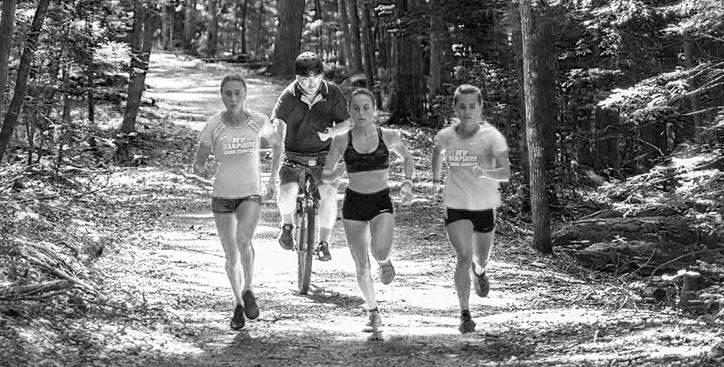
Eric Martinson is the store manager of Runner’s Al ley and has worked there for a year in a half. He started running his sophomore year of high school and says that, “cross country and the bond I had with my teammates make up most of my best memories from my high school years.” After high school, he got away from running for a few years and chose to pursue rowing crew in college. It wasn’t until a year or two after college when he was teaching high school English that running became a major part of his life again. He coached the track and field team at the school where he taught, and running became, “a much needed break and stress reliever from busy days of teaching, coaching, and dorm parenting,” he says. As the manager of Runner’s Alley, he gets to talk about running almost everyday with runners, walkers, and fitness enthusiasts from all over the Seacoast. He tries to sneak in a few miles on the trails before work each day, and, on occasion, joins a local road or trail race. He also organizes, volunteers at, and/or donates to many races throughout the year. He advises people interested in running to, “do it! Put one foot in front of the other and be sure to have fun. Don’t be afraid to start slow and mix a lot of walk ing and rest time into the early stages. Know that you have a support crew at Runner’s Alley that’s here to cheer you on, be a resource, answer questions, give advice, and get you geared up for success!”
 DURHAM’S RUNNING COMMUNITY
DURHAM’S RUNNING COMMUNITY
Who in their right mind would put themselves through a sport with 10-mile runs, no weather cancellations or off days? In the words of Cathy Schiro O’Brien, former Olympian, “some people might look and say ‘that person’s out of their mind’ but for me that’s living. I’m a better me by running.”
Despite its challenging nature, running is an essential part of many people‘s lives. Whether they race, run, coach, officiate, write about, or photograph running, there are so many ways to be in volved. Durham has many resources for runners, and the commu nity of people that this attracts is an empowering one. It’s hard to know why or when running became one of the area’s most successful and popular sports, but one thing is for sure: Durham is great for running, and running is great for Durham.
O’Brien and her husband chose to live in Durham specifically for the running community. “I could’ve lived anywhere but as a kid, I used to come over here for my long runs even though I lived in Dover. So even then I had a relationship with running in Durham,” she says. The town’s running community is exten sive. You can always find someone to run with regardless of age or ability. In Durham alone, there are the UNH teams, Oyster River teams, two outdoor and two indoor tracks, races such as the Homecoming race, Marina’s Miles, Bobcat Bolt, and many running trails such as College Woods, Powder Major, Kingman Farm, and the Sweet Trail. The running community also extends beyond people of college age. On Wednesdays at lunch, a group of adults run workouts on the UNH track. UNH Women’s Cross Country Head Coach, Robert Hoppler says, “I really admire the lunch bunch. They’re under recognized. These are the people that are creating a positive and welcoming community for running.”
This community truly is a positive one that is benefitting Durham. I grew up watching my mom run, and followed in her footsteps by joining the cross country team in high school. I have had many ups and downs with running but I’ve been able to fall back on my teammates. Sophomore year, I gave everything I had to running, missing social events to get in mileage, and constantly pushing myself to my limits. “Runner” encompassed my entire
Keira Ferris is a 6th grader at ORMS who runs cross country. She started cross country in fifth grade but has been running her whole life. She has always loved to run, “and it’s probably because I’m always running after my big sister,” she says. Ferris loves everything about cross country, the middle school team is fun and exciting, and her favorite part of it is when they play “get the femur” at the end of the season. “Get the femur” is like capture the flag except instead of a flag they use a plastic leg bone. Farris wants to continue to run in high school. She says, “it’s so much fun! I hope I can improve my time and get faster so I can be a top runner!”
Andy O’Brien (‘21), a varsity cross country and track runner at ORHS, is son to Cathy and Mike O’Brien. Mike has set two NH age group records in the 10K, and in the same year, he won the New England Grand Prix Championship. Andy says, “everyone in my family is very influential to me and seeing their accomplishments really motivates me. I can go to them for advice and know they are very experienced in what they’re saying.” Andy grew up watching his brother, Patrick O’Brien, who now runs for Dartmouth College, race at some of the iconic courses like Derryfield and Mines Falls that he now races himself. Andy hopes he has enough skill to be able to compete in college, which is a humble statement considering his championship season accomplishments this year. He placed second at the Division II Championships, and 18th at the All-Division Meet of Champions.
Cathy Schiro O’Brien is the winner of ‘84 High School Cross Country National Championship, a two time mara thon olympian, 1989 world record holder for 10 miles, and champion of the 1991 Los Angeles Marathon. In 7th grade, she started running with the Dover High School team, because her junior high school didn’t have a team. There weren’t a lot of sport options for females at the time. After high school she started running professionally and training for the Olympics. O’Brien hasn’t stopped running since she was twelve years old but her relationship with running has definitely changed over the course of the years, ages 12-51. “I’ve definitely grown to love it more and more. I’m not as fast anymore but I enjoy it more than I even did when I was fast,” she says. She enjoys it more now because running is a choice, and not for a team or profession anymore, and it has become one of her biggest social outlets. She adds, “it’s my favorite thing to do. It gives me a sense of purpose every day and it makes me feel young.” She loves to explore the area, and maintain her health.
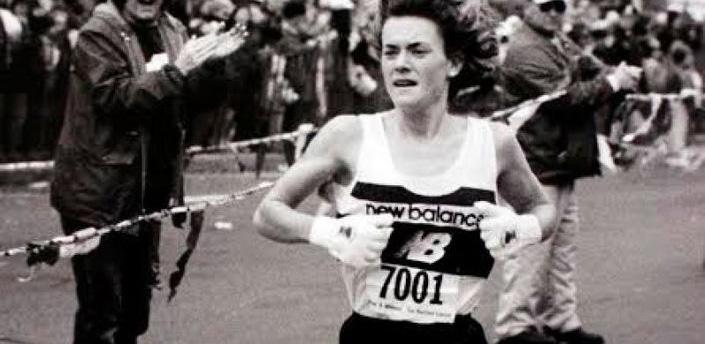
identity. Following that season, I had an overuse injury requir ing surgery. Every time I worked my way back toward varsity, I ended up injured again. And again. I wanted to quit. Many runners experience this. “It’s a sport where it can certainly break your heart, but you also learn a lot about hard work, discipline, resilience,” says Hoppler.
It took me an entire season to be successful in shutting out negative thoughts, but it was worth it. Most importantly, I started channeling my energy into being a leader and friend to my teammates. Their love and support have kept me invested in the sport that I’ve come to love so much.
Runners tend to agree that the sport’s community is a unique one; it’s very tight knit and supportive. The Bobcat Invitational cross country race is Madbury’s largest annu al event, just one testament to how running brings people together. Eric Martinson has been involved with the sport in many ways: as an athlete, coach, volunteer, and now as Run ner’s Alley’s store manager. He says, “I feel lucky that I get to meet new people each day and learn not only about their fit ness goals, but about their families, jobs, hobbies, and passions. It’s incredibly rewarding not only to help assist someone along their fitness journey, but to feel like you’ve made a friend in the process.” O’Brien’s son, Andy, who placed 2nd in NH’s DII Championship this year as a sophomore, speaks to this. He and his teammates train together year round, and he also runs into his competitors year round. “We all know that we have place or time specific goals and try and motivate each other to accomplish those,” he says.
And regardless of what time goals runners are trying to hit, running is inclusive. “Everyone is welcome no matter your speed. Personal improvement is just as important no matter where you are on the team,” says Cathy O’Brien.
Keira Ferris is a sixth grader on the Oyster River Middle School cross country team and loves running even though it’s really hard. She shows that there is no age or speed limit and says, “it’s fun to support other people when they race. The coaches are great and really cheer us on and are very posi tive. I may not be the fastest but it’s so much fun and I look forward to cross country season every year.”
For Hoppler, the best parts of the sport have been the people that he’s met, the friendships he’s made, and the places he’s been able to go. He also loves the sport’s longevity. “The ORMS cross country team was 2nd in the state this year. Those little kids are just starting, and then you have people older than me still running every day. Running stands the test of time.”
 -Phoebe Lovejoy
-Phoebe Lovejoy


Great Bay CrossFit’s High School Strength and Conditioning program is the perfect solution for preparing yourself mentally and physically for your sport. With our customized programming and atten tion to detail, you will be making progress with every workout, while staying injury free. Email us for more information: info@greatbaycrossfit.com



